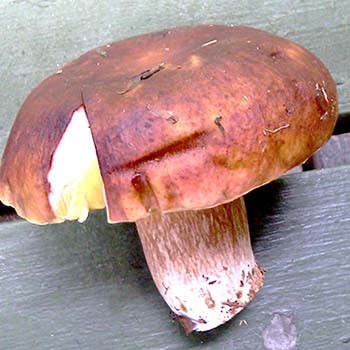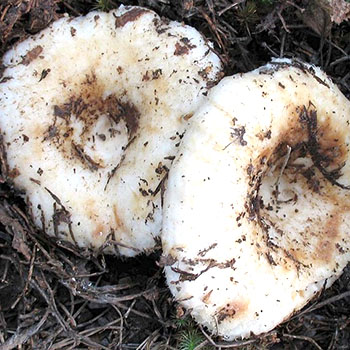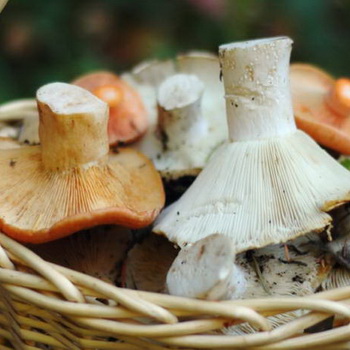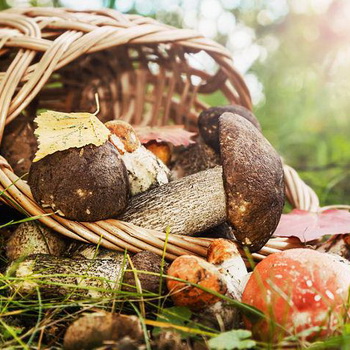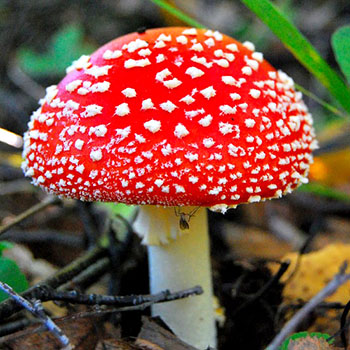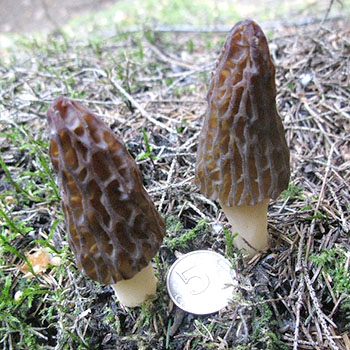What mushrooms grow in August

Wildly overgrown nature in the form of trees, shrubs, mosses gives many useful substances to mushrooms. In turn, many mushrooms contribute to the further prosperity of nature. This is their symbiosis. Although there are other examples when tinder fungi contribute to the destruction of trees and shrubs. However, scientists determined that the initial process is their weakening, and only then - the growth of mushrooms on them. This is the law of all nature. Plants, fungi, the animal kingdom mutate and adapt to external conditions, while the weak and sick quickly die, often due to other species.
With a description of the most popular types of mushrooms that grow in the Moscow Region in August, you can find it on this page.
Content
White mushrooms
Porcini mushroom, oak form (Boletus edulis, f. Quercicola).
Habitats: in the Moscow suburbs, ceps are apparently invisible; they grow singly and in groups in mixed forests with oaks.
Season: from late May to early October.
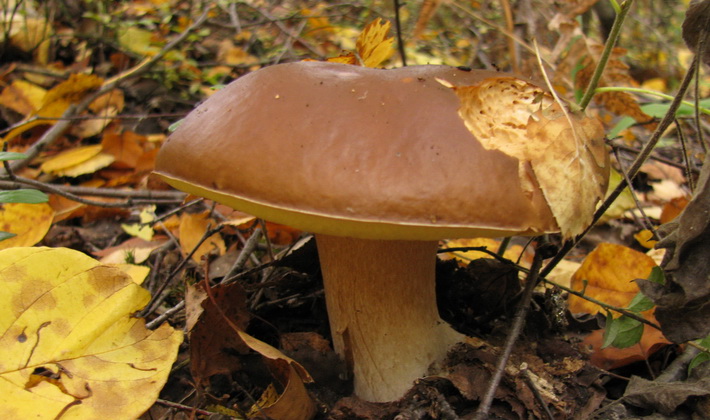
The cap is 5-20 cm in diameter, in young mushrooms it is convex, cushion-shaped, then flatter, smooth or slightly wrinkled. In wet weather, the hat is mucous, in dry - shiny. A distinctive feature of the species is a characteristic mesh pattern on the leg with reddish-brown shades. The color of the hat is highly variable, but more often in light colors - coffee, brown, grayish-brown, but there are also brown. The hat is fleshy and dense.
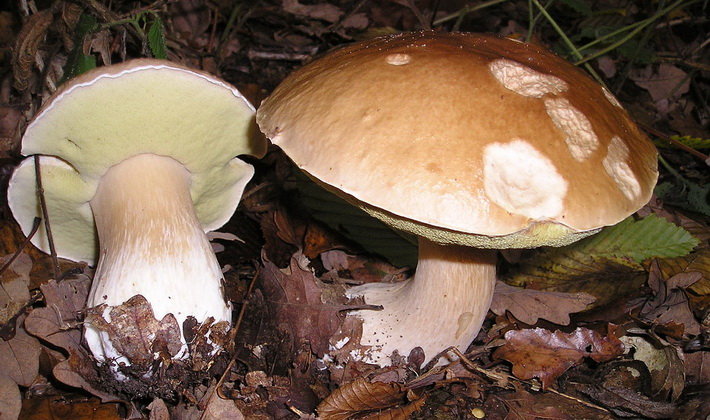
The leg has a distinct mesh pattern, often brownish. The height of the fungus is 6-20 cm, the thickness is from 2 to 6 cm. The leg in the lower part is expanded or club-shaped, in the upper part it is colored more intensely.
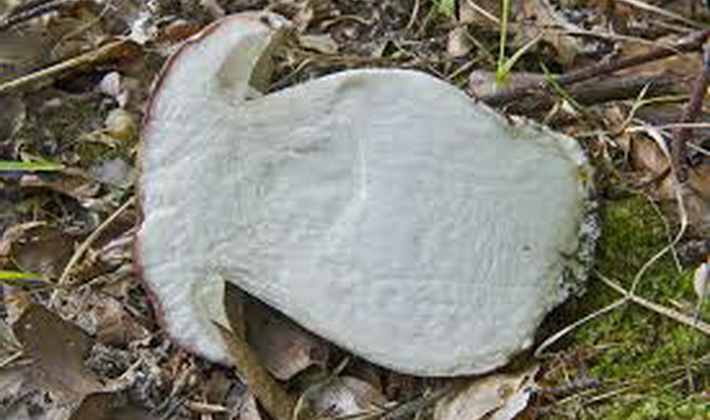
The pulp is dense, white, slightly spongy in maturity, yellowish under a tubular layer. The taste is sweet and has a pleasant mushroom smell.
The hymenophore is free, notched, consists of tubules 1-2.5 cm long, white, then yellow, with small rounded tubular pores.
Variability: the color of the hat varies from whitish-yellowish to light brownish; the leg in the upper part may have a color from light yellow to light brown.
There are no poisonous doubles. Inedible bile mushrooms (Tylopilus felleus), in which the flesh has a pinkish tinge and a burning bitter taste, are similar in size and color to the hats.
Cooking Methods: drying, pickling, canning, cooking soups.
Edible, 1st category.
Porcini mushroom, pine form (Boletus edulis, f. Pinicola).
Habitats: singly and in groups in coniferous and mixed with pine forests.
Season: from the beginning of July to half of October.
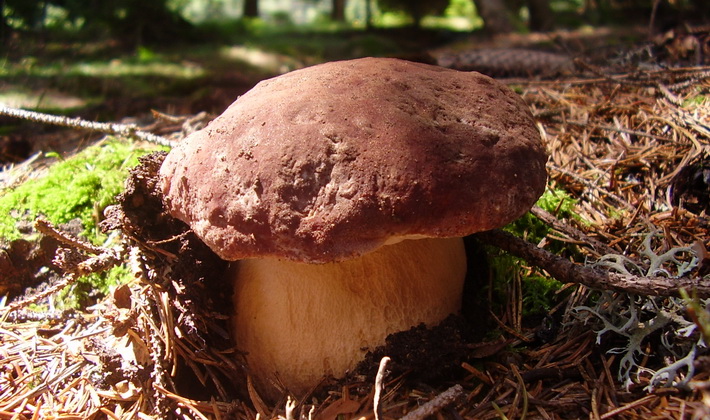
The cap is 5-25 cm in diameter, in young mushrooms it is convex, cushion-shaped, then flatter, smooth or slightly wrinkled. In wet weather, the hat is mucous, in dry matte.It is dark-colored: reddish-brown, reddish-brown, dark-brown, sometimes with a purple hue, in summer in dry forests it is lighter, often pink along the edge, to young whitish mushrooms. The edges are often pink or lighter. There are light stains on the hat. The peel is not removable.
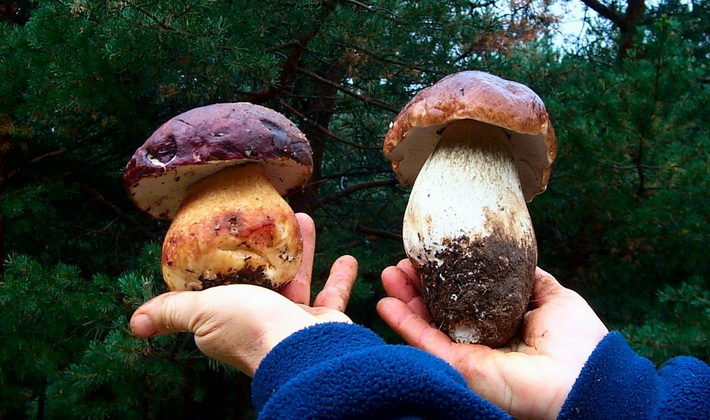
Leg is medium length, 5-8 cm tall, 1.54 cm thick, in the lower part very thickened. A distinctive feature of the species is the pattern on the leg - with stains or stripes, light brown in color, in the upper part the color is more intense.
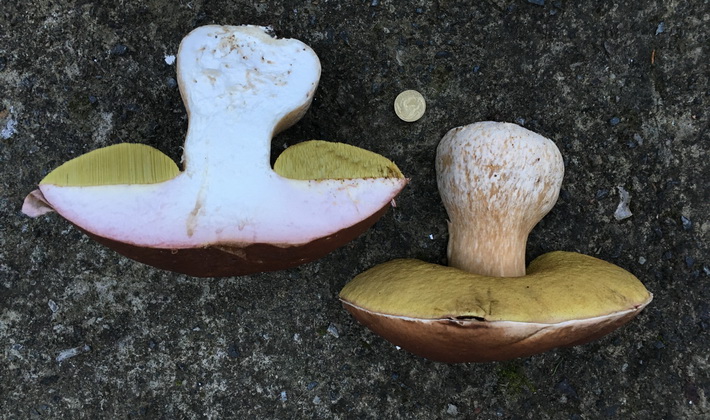
Pulp. The second distinctive feature is the brownish-red color of the pulp under the skin of mature mushrooms. It has no taste, but it has a pleasant mushroom smell. The pulp is not as dense as in other forms of cep.
The hymenophore is free, notched, consists of tubules 1-2.5 cm long, white, then yellow, with small rounded tubular pores.
Variability: the color of the hat varies from dark brown with an olive tint to light brown.
There are no poisonous doubles. Inedible bile mushrooms (Tylopilus felleus), in which the flesh has a pinkish tinge, an unpleasant odor and a very bitter taste, are similar.
Cooking Methods: drying, pickling, canning, cooking soups.
Edible, 1st category.
Boletus
Smoky boletus (Leccinum palustre).
Habitats: moist deciduous and mixed forests, grow in groups.
Season: July - September.

The hat is fleshy 3-8 cm in diameter. The shape of the hat is hemispherical, then cushion-shaped, smooth. The surface of the cap is slightly fibrous, dry, in wet weather - mucous. A distinctive feature of the species is the gray-brown color of the hat in young specimens, and later in smoky gray.
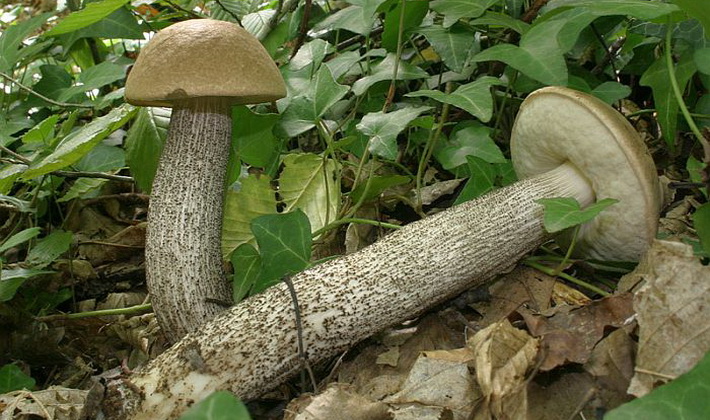
Leg 6-12 cm, 7-18 mm thick, cylindrical. In young mushrooms, the leg is solid and strong, and in mature ones, it is fibrous, slightly thickened from below. The second distinctive feature of the species is the color of the scales on the leg - not black, like most brown boletus, but light gray.
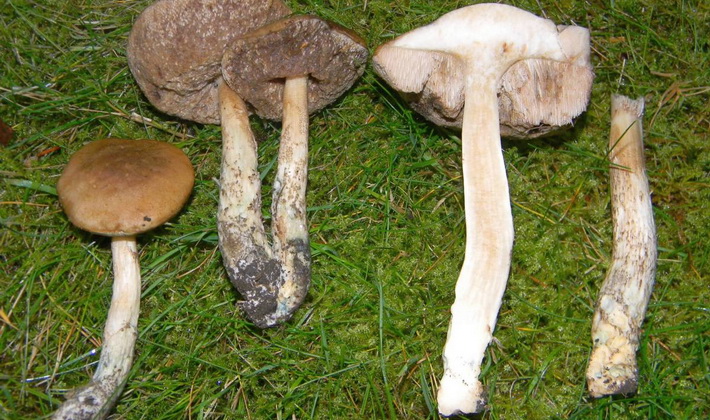
The pulp is first dense, later friable, acquires greenish-blue spots on the cut, has a pleasant faint mushroom smell.
Variability: the color of the hat varies from taupe to gray. As the mushroom ripens, the cap's skin can shrink, exposing the surrounding ducts.
There are no poisonous doubles.
Similar edible species. Smoky boletus in shape and sometimes color is similar to black boletus (Leccinum scabrum, f. Oxydabile), which differs not in light but in black scales on the leg.
Methods of preparation: drying, pickling, canning, frying.
Edible, 2nd category.
Multi-colored boletus (Leccinum varicolor).
Habitats: birch and mixed forests, singly or in groups.
Season: from late June to late October.
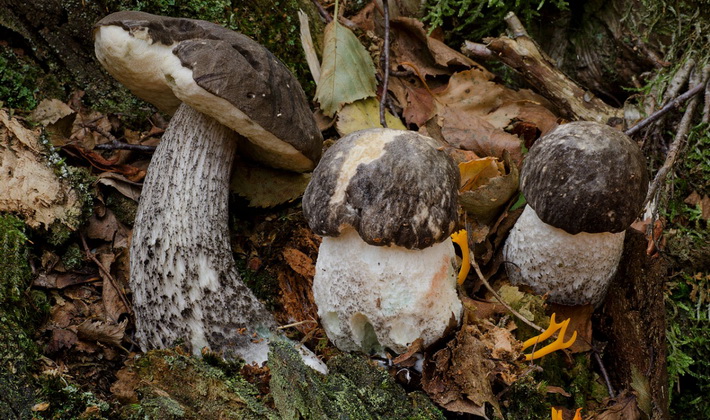
The hat is fleshy 5-15 cm in diameter. The shape of the cap is hemispherical, then cushion-shaped, smooth with a slightly fibrous surface. A distinctive feature of the species is light and dark spots on a dirty brown or reddish-brown hat. Often, the skin hangs over the edge of the hat.
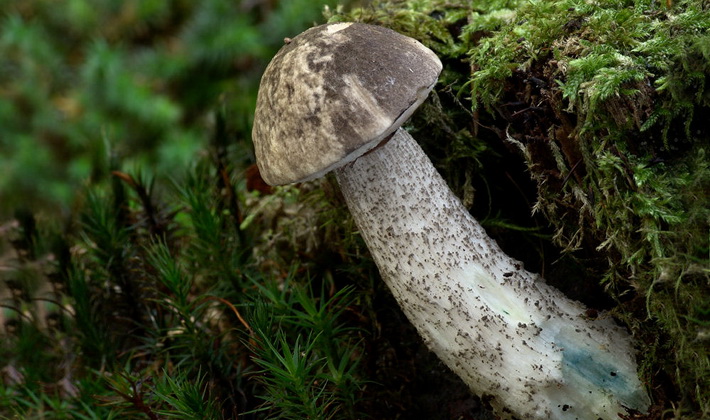
Leg 7-20 cm, thin and long, cylindrical, slightly thickened down. Young mushrooms have a slightly thickened bottom. The leg is white with scales that are almost black in mature mushrooms. Closer to the base of the hat, the scales are smaller and their color is lighter with a pale blue or greenish tint. Leg tissue in old specimens becomes fibrous and stiff. Thickness - 1.5-3 cm.
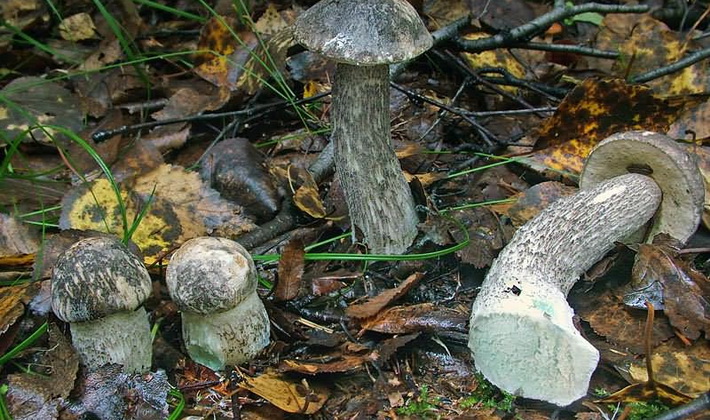
The pulp is dense whitish or loose, slightly watery. At the cut, the color slightly changes to a pink-turquoise color with a good smell and taste.
Tubules and pores have a color from white to cream and darken with age.
Variability: the color of the hat varies from light brown to dark brown to gray. The color of the spots is highly variable: from whitish to almost black. As the mushroom ripens, the cap's skin can shrink, exposing the surrounding ducts. The scales on the leg are gray at first, then almost black.
There are no poisonous doubles. A little like bile mushrooms (Tylopilus felleus), in which the flesh has a pinkish tinge, they have an unpleasant odor and a very bitter taste.
Cooking Methods: drying, pickling, canning, frying.
Edible, 2nd category.
Black boletus (Leccinum scabrum, f. Oxydabile).
Habitats: moist birch and mixed forests, grow singly or in groups.
Season: July - September.
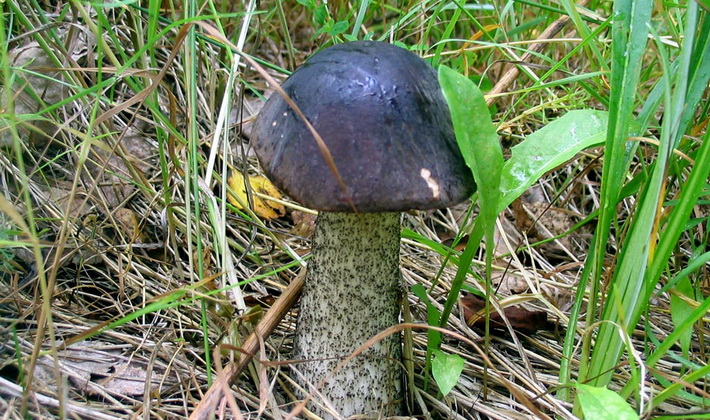
The hat is fleshy 5-10 cm in diameter. The shape of the hat is hemispherical, then cushion-shaped, smooth. The surface of the cap is slightly fibrous, dry, in wet weather - mucous. A distinctive feature of the species is black, black-brown, gray-brown. The hat has a vague spotty pattern.
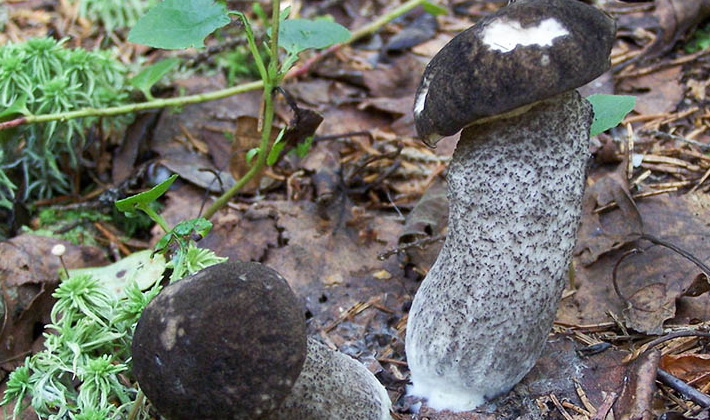
Leg 6-12 cm, thin and long, cylindrical. Young mushrooms have a slightly thickened bottom. The leg is white with black-brown small scales, which are almost black in mature mushrooms, and white at the base. Leg tissue in old specimens becomes fibrous and stiff. Thickness - 1-2.5 cm.
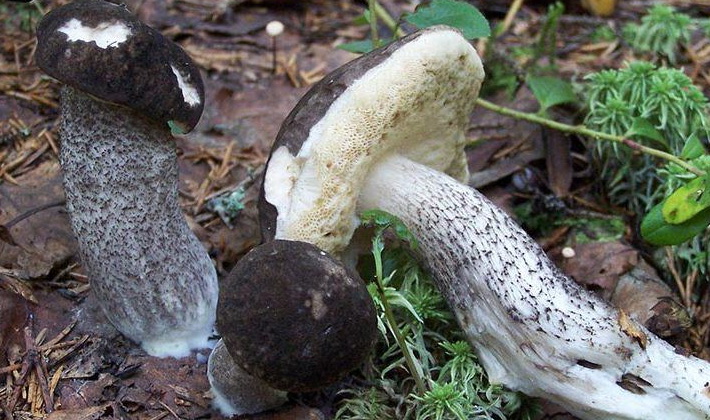
The pulp is dense, does not change color on the cut, the down is gray. The pulp is dazzlingly white, but darkens at the cut.
Tubules brownish-grayish 1.5-3 cm with teeth.
Variability: the color of the hat varies from gray-brown to black. As the mushroom ripens, the cap's skin can shrink, exposing the surrounding ducts. The scales on the leg are gray at first, then almost black.
There are no poisonous doubles.
Cooking Methods: drying, pickling, canning, frying.
Edible, 2nd category.
Butter
Oilfishes, unlike boletus, do not like dense forests, and they grow most often on illuminated slopes or in bright glades near a forest strip.
In August, there is a lot of oil, but not every year. Peak harvest is observed after two to three years.
Therapeutic properties:
- has antibiotic activity;
- contains a special resinous substance that relieves acute headaches (chronic arachnoiditis) and facilitates the condition of patients suffering from gout, accelerates the excretion of uric acid.
Butterdish (Suillus luteus).
Habitats: young pine forests and mixed forests, along the edges of forest glades, at the edges, along forest roads.
Season: May - early November
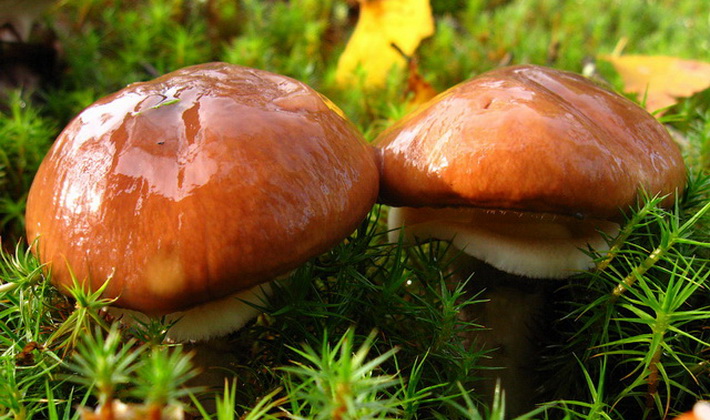
The cap is 4-10 cm in diameter, sometimes up to 13 cm, hemispherical, then round-convex and then flat, smooth. Color - brown, dark brown, chocolate brown, less yellow-brown and brownish-olive. In wet weather, the hat is covered with mucus, in dry weather it is shiny, silky. In young mushrooms, the edges of the cap are connected to the stem with a dense film, which breaks as it grows and forms a ring around the stem. The peel is easily removable.
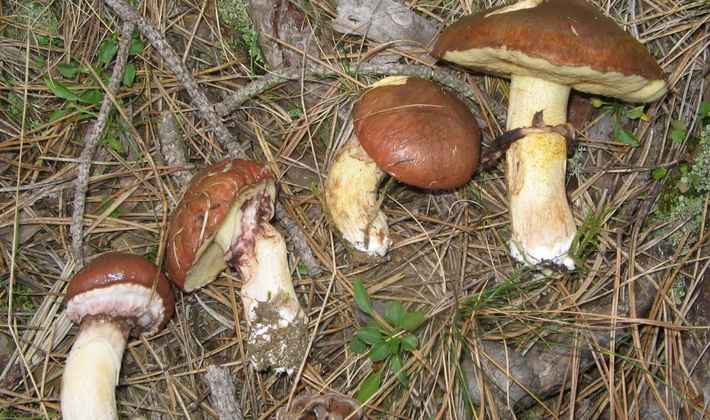
Leg 3-10 cm tall, 1-2.5 cm thick, cylindrical, whitish or slightly yellowish, later brownish over the ring. The ring is first white, then brown or dirty purple.

The pulp is soft, white, light yellow, does not change color at the break, with a faint smell and taste.
The hymenophore has grown, consists of tubules 0.6-1.4 cm long yellow. The pores of the tubes are small, round, first whitish, then yellow. Spore powder is rusty yellow.
Similar views. An ordinary butterdish is similar to an edible granular butterdish (Suillus granulatus), which has a similar color range of hats and legs, but does not have a ring on the leg, and it has grit.
There are no poisonous doubles. A little like bile mushrooms (Tylopilus felleus), in which the flesh is pinkish, the hat is brown, they are very bitter.
Cooking Methods: drying, pickling, boiling, salting.
Edible, 2nd category.
Granular butterdish (Suillus granulatus).
Habitats: grows in coniferous and deciduous forests, especially under pine trees.
Season: July - September.
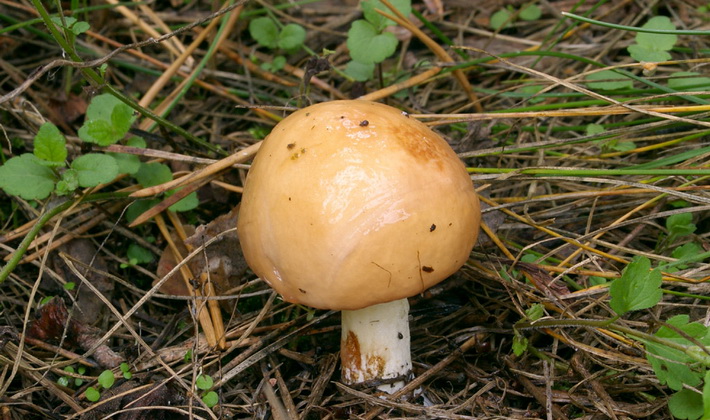
A hat with a diameter of 3-9 cm, fleshy and elastic, sticky, shiny rusty brown or yellow-orange. The shape of the cap is first hemispherical and conical, then convex and then almost open and even with the edges bent up. The skin is smooth and easily detachable from the cap.
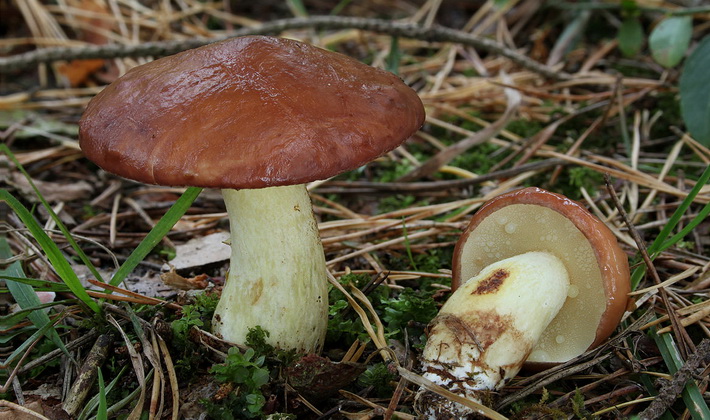
The leg is dense, cylindrical, slightly curved, yellowish-whitish, mealy-granular, or light reddish-brown, 4-7 cm high, 0.8-2 cm thick, with yellow spots on the surface. In the upper part, the view is fine-grained.
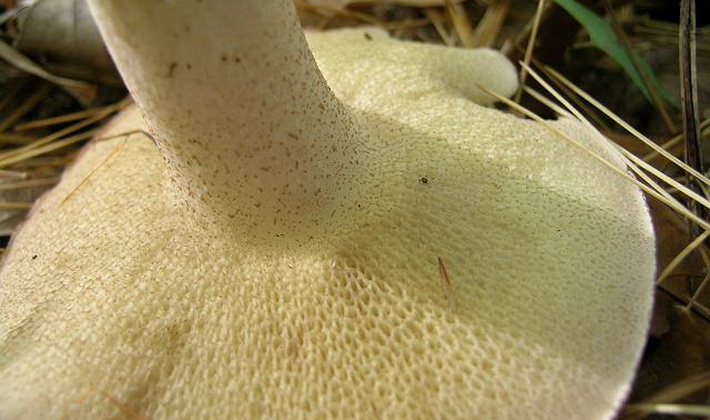
The pulp is tender, soft, does not change color at the break, light yellow with a nutty smell, the taste is sweetish.
The tubules are adherent, short 0.3-1.2 cm of light yellow or light brown color. The pores are small, with sharp edges, emit droplets of milky juice, which when dried forms a kind of brownish coating.
The spores are light brown.
Variability. The color of the hat changes from ocher and yellow-cream to tan and rust-brown. The color of the legs is from light yellow to light brown. The granular surface of the legs is first cream yellow, then brownish. The pores are first pale yellow, then yellowish. The tubules may be yellowish and greenish.
There are no poisonous doubles. A little similar bile mushrooms (Tylopilus felleus), in which the flesh is pinkish, and the hat is brown, they are very bitter.
Cooking Methods: drying, pickling, boiling, salting.
Edible, 2nd category.
Reddish oiler (Suillus tridentinus).
Habitats: coniferous forests, found singly and in groups. The red-red butterdish is included in the regional Red Books of the central regions of Russia. Status - 4I (view with undefined status). It is more common in Western Siberia.
Season: end of May - beginning of November.
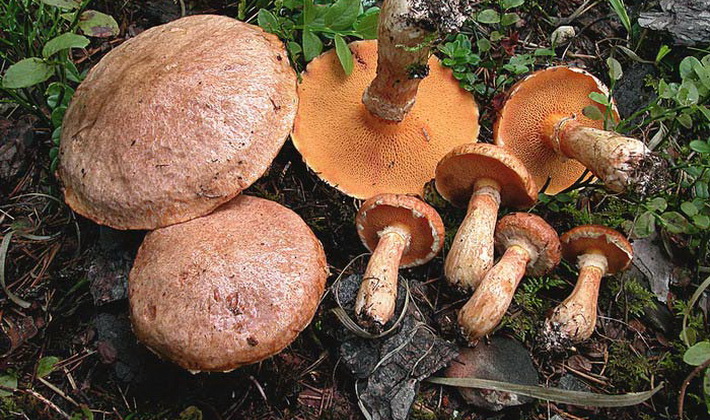
A hat with a diameter of 4-12 cm, found up to 15 cm. A distinctive feature of the species is a yellowish-orange hat with a convex pillow-shaped shape. Ripe mushrooms are almost flat, red-red. The surface is covered with thick orange-red fibrous scales, and it looks like cracked with a light mesh. At the edges there are remains of a white bedspread.
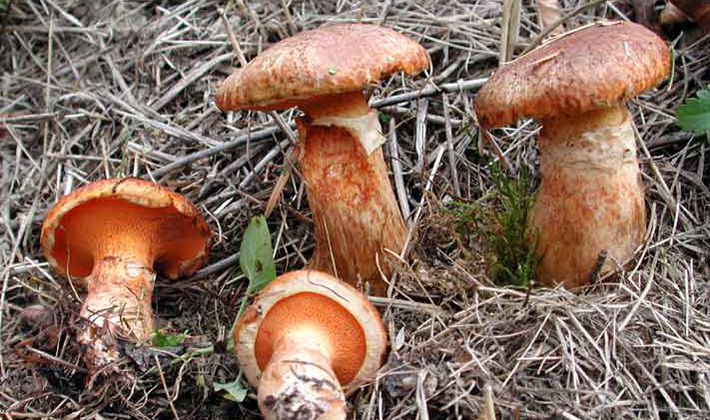
Leg 4-10 cm, yellowish-orange, may taper slightly above and below. There may be a ring in the upper part of the leg, but it can be imperceptible. The thickness of the legs is 1-2.5 cm. The color of the legs is the same as the hat, or a little lighter.
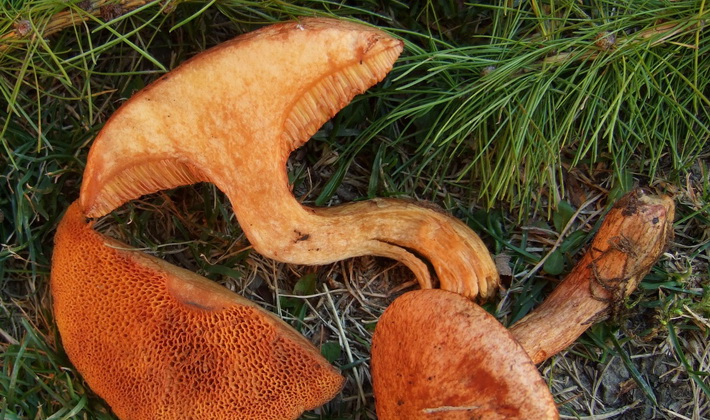
The pulp is dense, lemon-yellow or yellowish, with a faint mushroom smell, it turns red at the break.
The spores are olive yellow. The hymenophore has grown, descending, consists of tubules 0.81.2 cm long, yellowish.
Variability. The color of the cap during the growth of the fungus varies from light orange to red-red and even brownish-red.
There are no poisonous doubles.
A little like bile mushrooms (Tylopilus felleus), in which the flesh is pinkish, the hat is brown, they are very bitter.
Cooking Methods: drying, pickling, boiling, salting.
Edible, 2nd category.
Russula
In August, many species of russula grows. Among them there are therapeutic russula, such as marsh, growing in moist places.
Marsh Russula has antibiotic properties against pathogens of various diseases - staphylococci and against harmful bacteria - pullularia. Tinctures based on these fungi have antibacterial properties and are able to suppress the reproduction of staphylococci.
Russula marsh (Russula paludosa).
Habitats: in damp coniferous or mixed forests, in swamps.
Season: June - October.
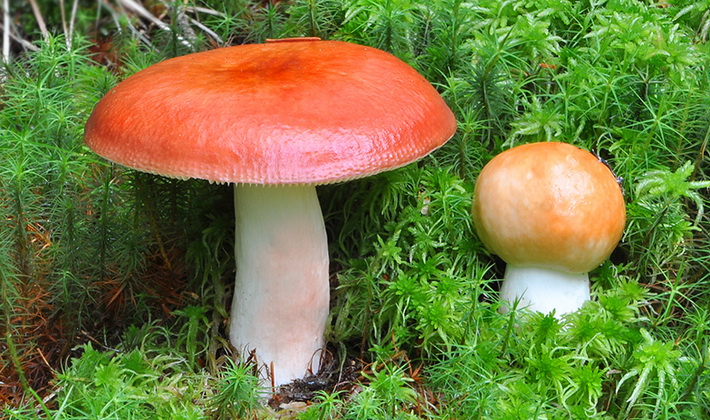
The hat has a diameter of 4-12 cm, it can be up to 18 cm. The shape is initially convex hemispherical, later - flat-pressed reddish. A distinctive feature of the species is a slightly indented hat of a pinkish-reddish color with yellow-brown spots in the center of the hat. The surface in wet weather is sticky. The skin is smooth, shiny, sometimes covered with small cracks.
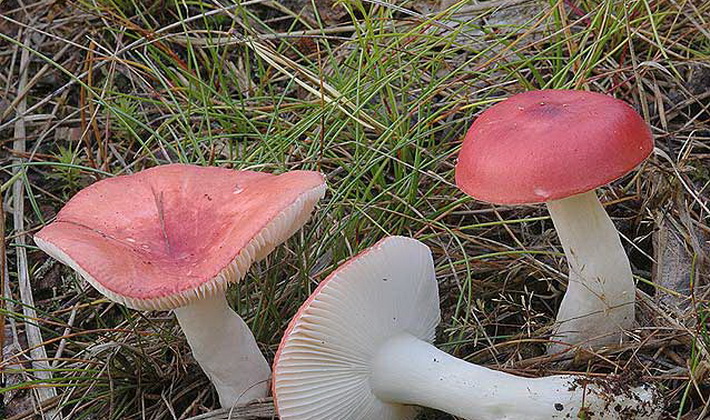
Leg: 4-12 cm long, 7-22 mm thick. The shape of the leg is cylindrical or slightly club-shaped, white in color with a pinkish slightly shiny tint. In old mushrooms, the leg becomes grayish.
The plates are frequent, wide, with slightly jagged and reddish edges. The color of the plates is first white, then creamy yellow, light golden. The plates of the legs are bifurcated.
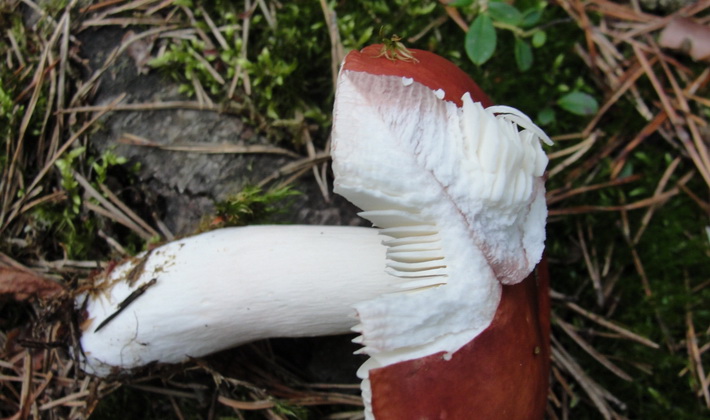
The pulp is dense, white, fragile, with a sweetish taste.Only young mushrooms have slightly caustic plates.
The spores are light buffy. Spore powder is pale yellow.
Variability. In young mushrooms, the edges of the cap are smooth and become scarred with age. The color of the hat may be orange-red and fade with age. The leg is completely white at first, but becomes pinkish with age.
Similarity to other species. The swamp russula can be confused with a burning vomit (Russula emitica), which have a white leg and a sharp pepper taste, a burning red hat and there is no other color in the center.
Cooking Methods: pickling, boiling, salting, frying.
Edible, 3rd category.
Russula browning (Russula xerampelina).
In August, browning russules appear in many moist places with a pungent pungent taste.
Habitats: in moist pine, oak and mixed forests, on sandy soils.
Season: July - early November.
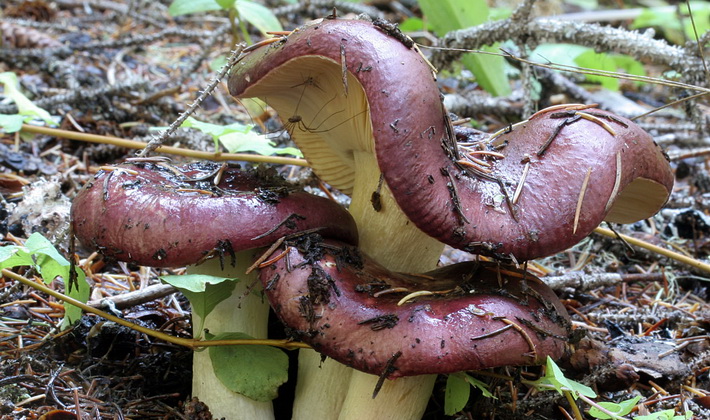
The hat has a diameter of 4-12 cm, dark red or brown-purple. The shape of the cap is first convex, then open or flat-depressed. In the center of the cap there is a darker depressed or concave area. The edges become strip-ribbed over time. The surface of the cap is first slightly mucous, then dry, dull. The peel is easily detachable.
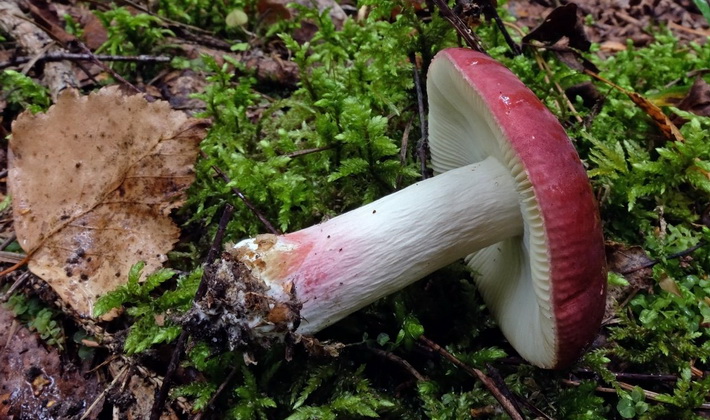
Leg 4-12 cm in diameter and 1-3 cm thick, smooth, cylindrical, first white, then acquires a reddish-pink hue, may have pinkish-purple spots. The base of the leg is often thickened. The leg is almost hollow.
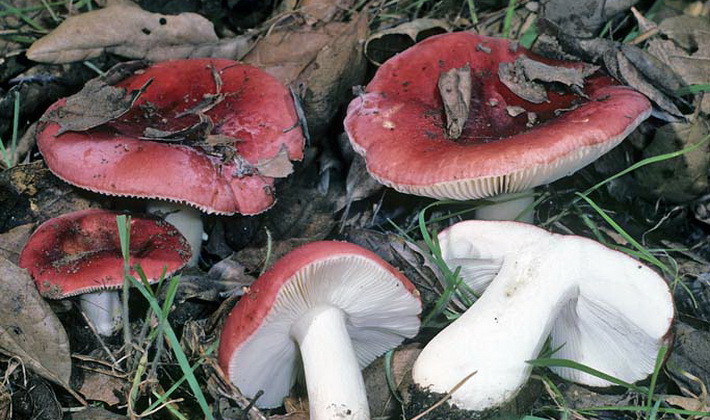
The pulp is dense, fragile, white or creamy cream, with age it becomes yellowish-brown or brownish, turning brown at the break, which is a hallmark of the species. The taste of pulp is pleasant, sweet-nutty. The smell, on the contrary, is unpleasant, like herring.
The plates are grown or loose, frequent, creamy white, then yellowish-ocher, when pressed brown, 7-12 mm, fragile, rounded at the edge. Spores are buffy, spore powder is pale buff.
Variability. The color of the hat can vary from purple-red to brown-red, olive, sometimes with a greenish or purple hue.
Similarity to other species. The browning Russula is similar to the edible honey Russula (Russula meliolens Quel), in which the hat is red or reddish-brown and does not have a darker area in the center of the hat.
Cooking Methods: pickling, boiling, salting, frying.
Edible, 3rd category.
Russula browning, reddish form (Russula xerampelina, f. Erythropes)
Habitats: in moist pine, oak and mixed forests, on sandy soils.
Season: July - early November.
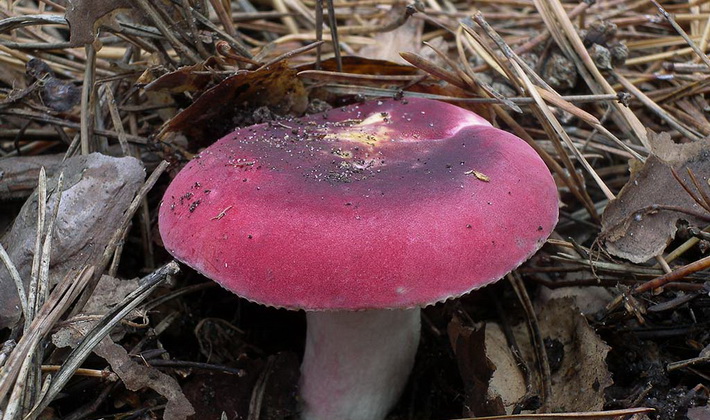
The hat has a diameter of 4-10 cm, dark red or brown-red. The shape of the cap is first convex, then open or flat-depressed. In the center of the cap there is a small indented area. The edges become strip-ribbed over time. The surface of the cap is first slightly mucous, then dry, dull. The peel is easily detachable.
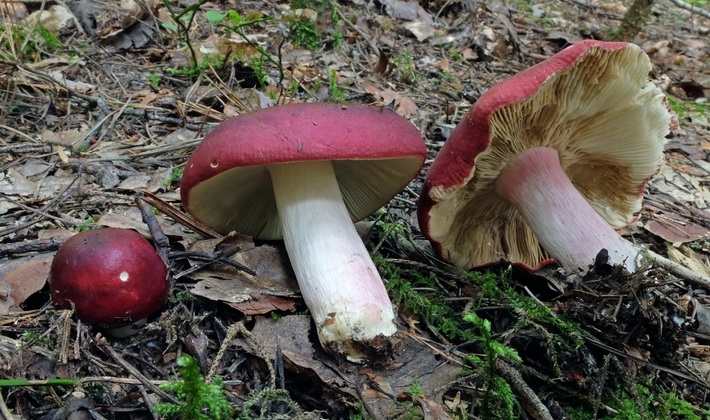
Leg 4-12 cm tall and 7-20 mm thick, smooth, cylindrical. A distinctive feature of the species is the pink-red color of the legs. The base of the leg is often thickened. The leg is almost hollow.
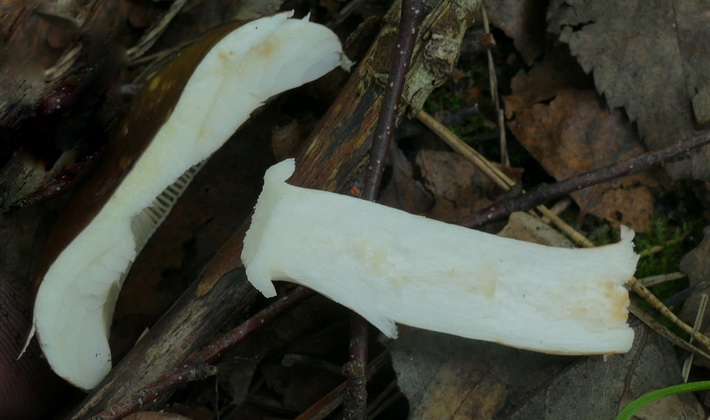
The pulp is dense, fragile, white or creamy cream, with age it becomes yellowish-brown or brownish, turning brown at the break, which is a hallmark of the species. The taste of pulp is pleasant, sweet-nutty. The smell, on the contrary, is unpleasant, like herring.
The plates are grown or loose, frequent, creamy white with pinkish spots, when pressed brown, 7-12 mm, fragile, rounded at the edge. Spores are buffy, spore powder is pale buff.
Variability. The color of the hat can vary from purplish red to brown red.
Similarity to other species. This species is similar to the edible honey russula (Russula meliolens Quel), in which the hat is red or reddish-brown and does not have a darker area in the center of the hat.
Cooking Methods: pickling, boiling, salting, frying.
Edible, 3rd category.
For some reason, among the majority of the country's population, there was an opinion about the edibility of all russula. This is actually not the case.In foreign literature, about half of russula are inedible, in Russian reference literature, about 20% of russula are inedible, for example, russula are stingy, Myra and feloid are inedible, and wavy and blushing are conditionally edible. We focus on this, since there are cases when even tourism instructors allow students or schoolchildren to lightly fry the russula at the stake and have them all indiscriminately. The word "russula" they understand in a direct sense. The sad results of such an indiscriminate use of russula are known. Most bright red Russula in Europe are considered inedible. This does not mean that other types of russula grow there. They are the same. This means that in Europe they are more attentive to the properties of long-term harmful accumulation of properties from the use of these mushrooms. In addition, they are safe from similar bright red inedible and even poisonous russula. We trust our Russian sanitary regulations. They have changed. Now the Federal Sanitary Rules, Norms and Hygienic Standards of SP 2.3.4.009-93 are in effect. Sanitary rules for the harvesting, processing and sale of mushrooms. "
Russula felted (Russula farnipes).
Habitats: deciduous and beech forests grow on acidic soil. A rare species listed in the regional Red Books, status - 3R (rare species).
Season: June - September.
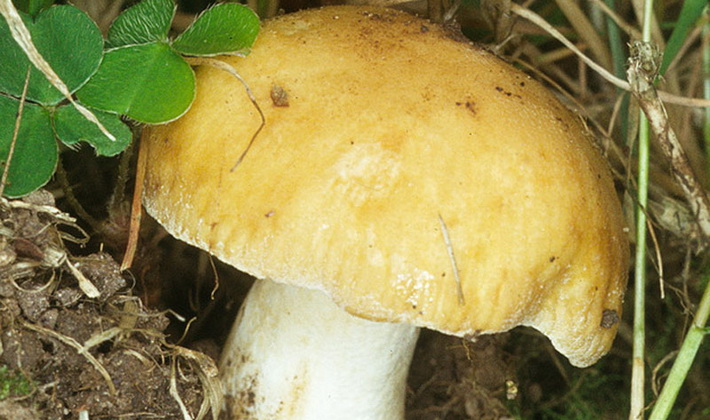
The cap is 4–9 cm in diameter, sometimes up to 12 cm, smooth, dense, sticky at a young age, then dry, thin-fleshed. Hat color: ocher-orange, ocher-yellowish, brownish-yellowish or dull yellow. The center of the cap is slightly depressed and has a darker color with a light olive color. The shape of the cap is first convex, then close to flat or concave-open. The edge of the cap is flat at first, but becomes wavy with age, often with a torn ribbed edge. The peel is removed.
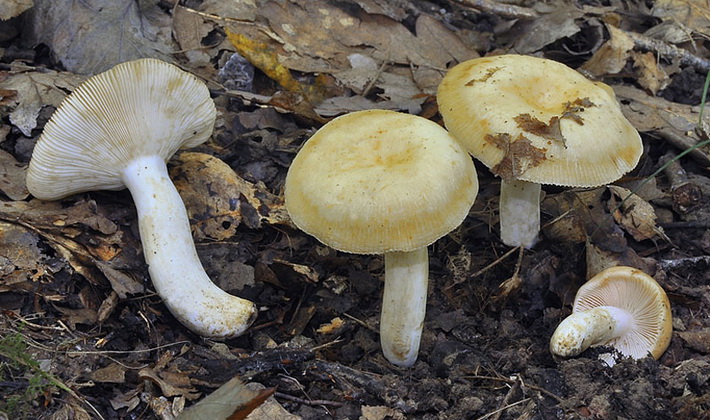
The leg is thick, 4-8 cm high, 8-20 mm in diameter, sometimes eccentric, has exactly the same color as the hat. The leg is narrowed downward, and powdery powdery above.
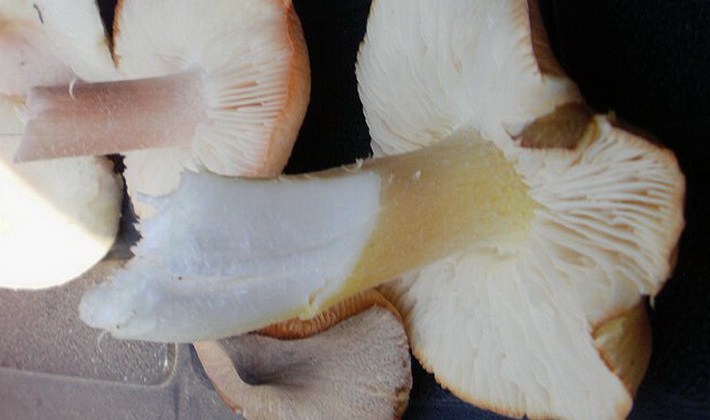
The pulp is dense, whitish, elastic, pungent, yellowish under the skin, with a pleasant mushroom smell and a very sharp pungent taste.
The plates are white, cream when dried. They are frequent and forked, narrowly grown. With age, the plates become dirty and cream and secrete drops. The spores are whitish.
Variability. The hat is whitish-yellowish at first, and the leg is almost white. Later, the hat becomes straw yellow with a light olive, sometimes with a brownish-yellowish middle.
Similarity to other species. A similar color is the light yellow Russula (Russula clavoflava), in which the hat is plain, there is no central darkening, and it is thick-fleshy, the plates are frequent, light yellow, the leg is white or grayish.
Conditionally edible due to the sharp pungent taste.
Russula Velenovsky (Russula Velenovskyi).
Habitats: well-heated places in mixed and coniferous forests.
Season: June - September.
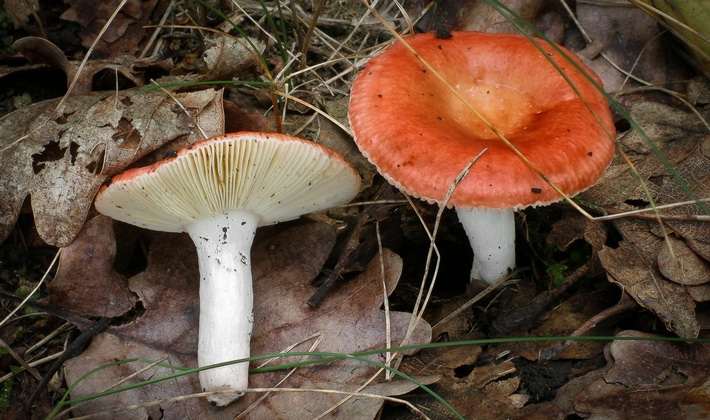
The cap is 4–8 cm in diameter, sometimes up to 12 cm. A distinctive feature of the species is a convex, uneven, fine-tuberous, hemispherical cap of egg-red color. The center of the cap is flattened, and sometimes slightly depressed and has a darker shade.
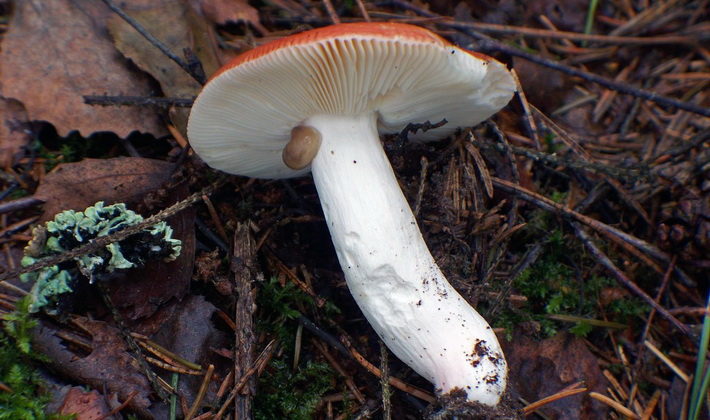
The leg is cylindrical or slightly conical with an extension downward, 4-10 cm high, 8-20 mm in diameter. In young mushrooms the leg is white, in mature ones it is pinkish.

The pulp is dense, whitish, elastic, with a pleasant mushroom smell.
Records. The second distinctive feature of the species is the very frequent plates, which are white in young mushrooms and slightly pinkish in mature ones.
Variability. The color of the hat varies from egg to orange-reddish.
Similarity to other species. It is necessary to distinguish Russula Velenovsky from the poisonous burning caustic Russula (Russula emitica), which in young specimens has a similar shape, but differs in a bright blood-red color of the hat.
Edible, 3rd category.
Russula undulate (Russula undulate).
Habitats: mixed forests, grow in groups on acidic soil, especially often under oaks.
Season: July - September.
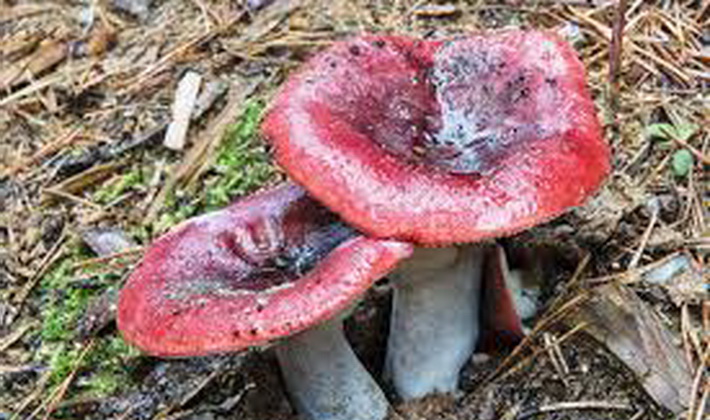
The cap is 4–9 cm in diameter, first convex, later spread out with a dented center or flat. The color of the hat is pink-brown or brownish-purple. In the center of the cap is a darker brownish tint or yellowish-brown spots. A distinctive feature of the species is wavy edges. In addition, there are cracks at the edges. The surface is smooth, dry.
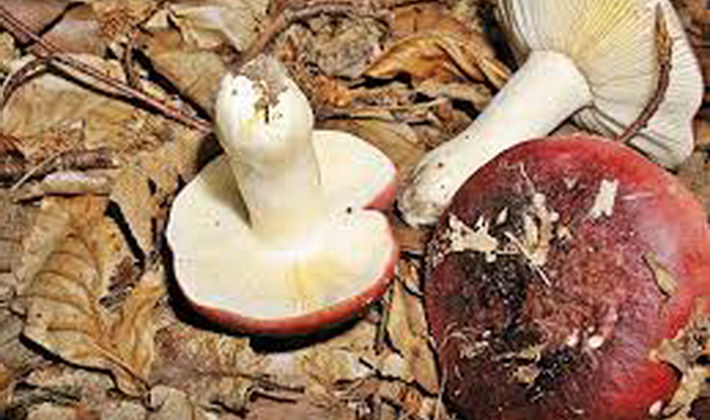
Leg 4-8 cm tall, thick, with a diameter of 8-25 mm, short, with time becoming club-shaped. The color of the legs is first white, later cream.
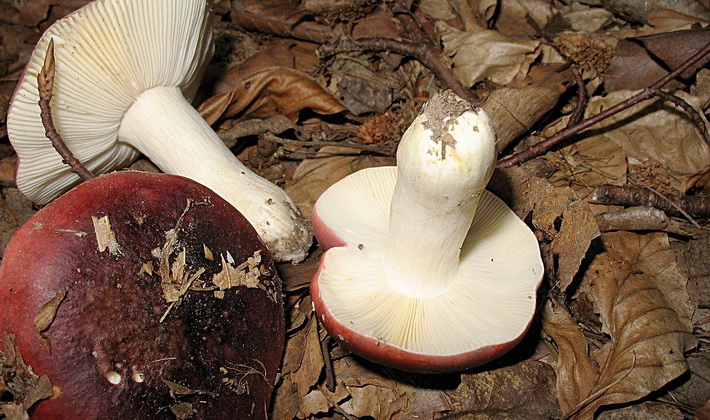
The pulp is white or gray with a pungent spicy taste. The spores are white.
The plates are white, narrowly grown, then cream.
Variability. The color of the hat is variable: reddish, pinkish, rust-brown, brownish with a purple tint.
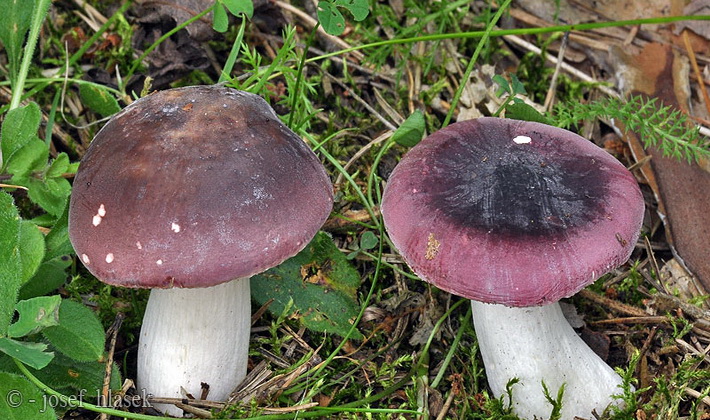
Similarity to other species. Is similar russula turkish (Russula turci), which may have a similar brownish-violet color, but differs in smooth edges, a shiny surface of the cap, as well as the presence of a fruity smell of plates.
Edibility: mushrooms can be eaten after 2 single boiling with water change to soften the sharp pungent taste. Used for cooking hot seasonings.
Conditionally edible due to the sharp, pungent taste.
Russula maiden (Russula puellaris).
Habitats: conifers, less often in deciduous forests, grow in groups and individually.
Season: July - September.
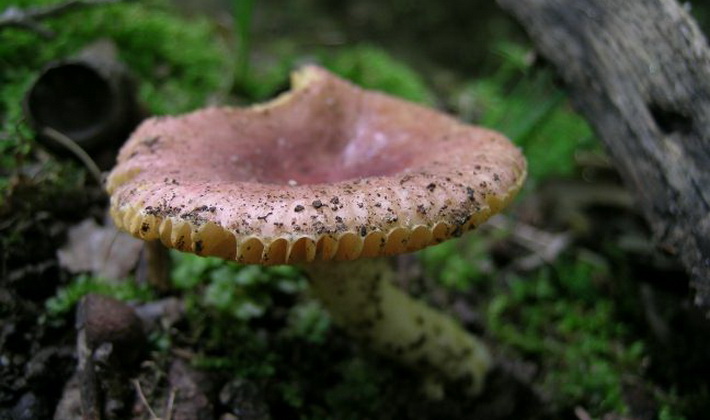
The hat is 3-7 cm in diameter, first convex, later convex-prostrate and slightly depressed with a thin ribbed edge. Hat color: brown-gray, reddish-brown, reddish-brick and yellowish-gray. A distinctive feature of the species is dark brown or later almost black in the center. The skin is shiny, slightly sticky. The hat with age and when pressed becomes ocher-yellow.
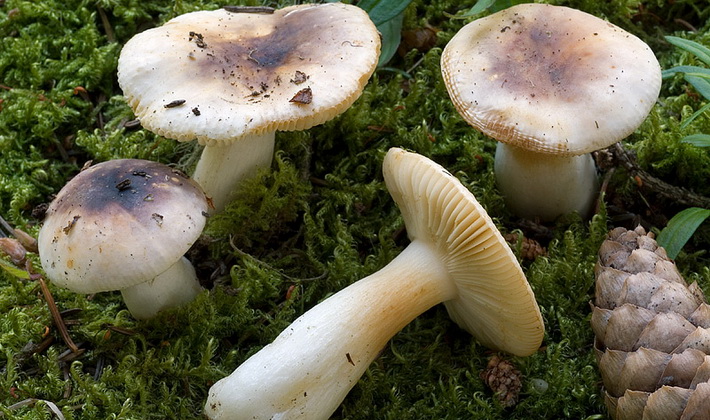
Leg 3-6 cm tall and 0.5-1.5 cm thick, dense cylindrical, slightly expanded to the base, first solid with a spongy center, later hollow, brittle. The color of the legs of young mushrooms is almost white, later yellowish.
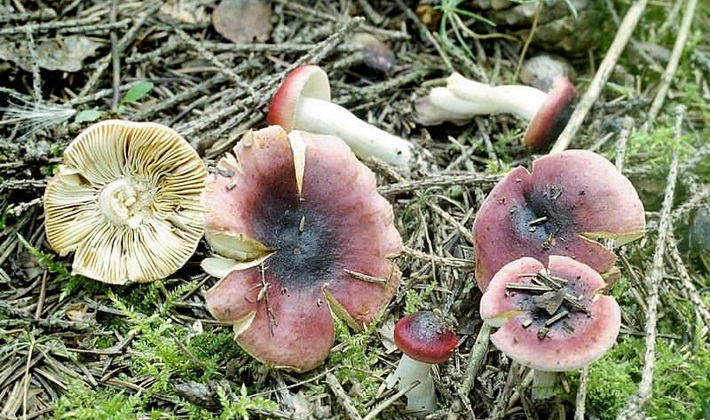
The flesh is thin, friable, brittle, whitish, yellowish, without any special smell; it becomes ocher-yellow in the section.
Records: thin, grown or almost free, first white, then yellow, ocher yellow, cream. Spore powder light-ocher.
Variability. Hats at the edges can change color from reddish-brick to yellowish, and in the middle - from brown to black.
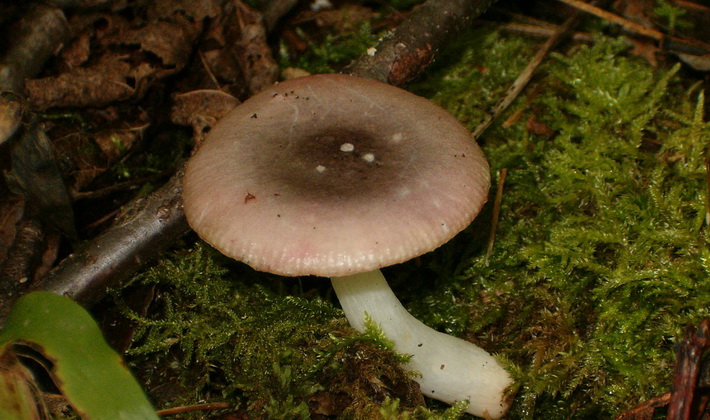
Similarity to other species. Russula maiden is a bit like an edible Russulafragile (Russula fragilis), which does not have such a contrast in the colors of the middle of the cap and edges, but has a smooth transition.
Cooking Methods: fried, pickled, salted.
Edible, 3rd category.
Russula is burning-caustic (Russula emitica).
Habitats: in deciduous and coniferous forests and in swamps.
Season: July - October.
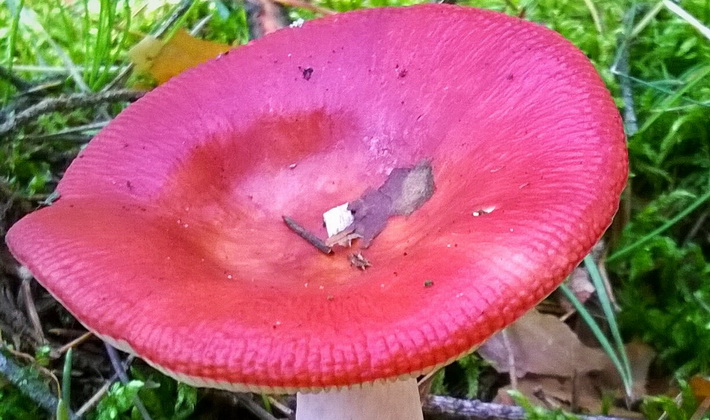
The cap is 4-10 cm in diameter, first convex, hemispherical, later prostrate and flat, slightly depressed in the middle. The surface of young mushrooms is sticky, then it becomes shiny and smooth with a blunt ribbed edge. A distinctive feature of the species is a bright blood red, red or purple color of the hat. The skin is easily separated from the pulp of the hat.
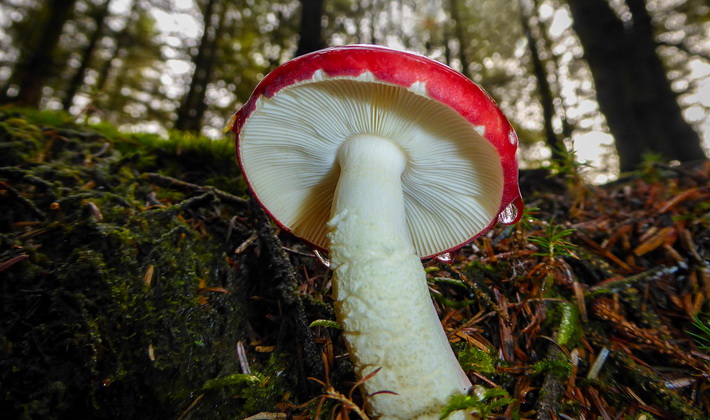
Leg 4-7 cm tall, 8-20 mm thick, cylindrical in young specimens and club-shaped in old ones, with a bloom. The leg is white, brittle, sometimes pinkish.
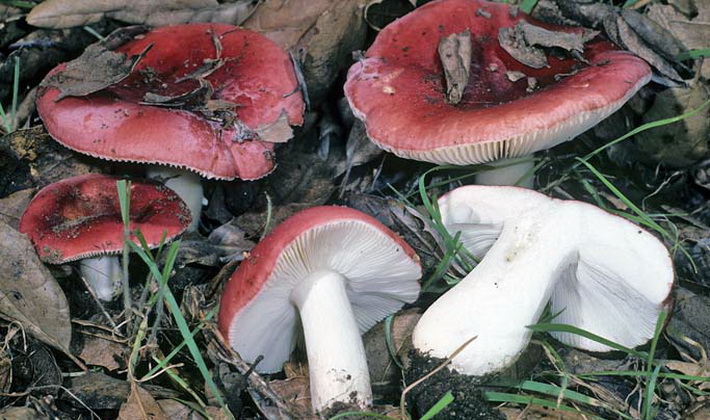
The pulp is white, pinkish under the skin, dense, later friable. The second distinguishing feature of the species is the very burning taste of the pulp when it nibbles on the tongue, although it has a faint pleasant fruity smell.
Medium-frequency plates, 0.5-0.8 cm wide, white, narrowly grown or loose, of the same length. Over time, the plates become yellowish or light cream. Spore powder is white.
Variability. The color of the hat can change color from blood red to brownish purple.
Similarity to other species. There are several types of reddish russula: marsh (Russula paludosa), beautiful (Russula pulchella), food (Russul vesca).The hot-caustic Russula can be clearly identified and distinguished by its brightest red color and a hot-caustic pungent taste.
In foreign literature, it refers to poisonous species, in some domestic literature it refers to conditionally edible.
Inedible due to a burning, caustic taste.
Russula golden yellow (Russula lutea).
Habitats: deciduous and mixed forests. Russula golden yellow are rare species and are listed in the regional Red Books.
Season: July - September.

The cap is 2-7 cm in diameter, sometimes up to 10 cm, first hemispherical, convex, later convex-prostrate or flat, fleshy, slightly depressed with smooth edges. A distinctive feature of the species is the presence of a tubercle in young specimens, a flat-concave shape in mature mushrooms of golden yellow or orange-yellow color. The surface is dull, dry.

Leg 4-8 cm tall, 6-15 mm thick, cylindrical, expanding at the base even, initially dense, smooth, white, then hollow and pinkish.
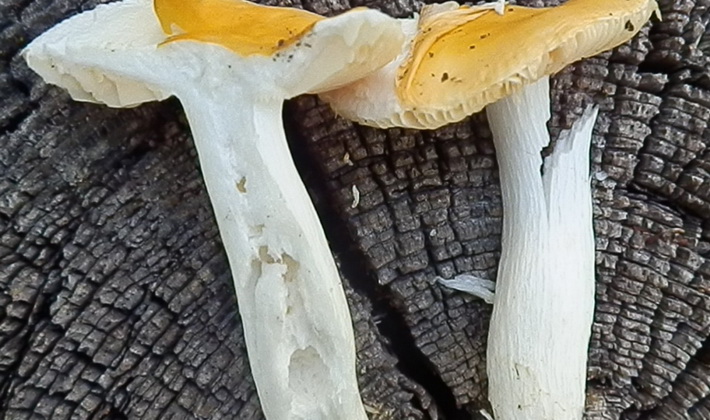
The pulp is dense, white, does not change color at a break, without a pronounced smell and taste.
Medium-frequency plates, slightly grown, first white, later orange-ocher.
Variability. The color of the hat can vary from tan to bright orange-yellow.
Similarity to other edible species.Russula golden yellow can be confused with Russula golden (Russula aurata), which is distinguished by ribbed edges and a round hemispherical shape in young specimens.
The difference from the poisonous fly agaric bright yellow (Amanita gemmata) with a similar hat color is that the fly agaric has a wide ring on the leg and a volva at the base.
Cooking Methods: pickling, frying, salting.
Edible, 3rd category.
Russula Golden (Russula aurata).
Habitats: deciduous, mainly oak and mixed forests. Russula Golden is a rare species and is listed in the regional Red Books, status - 3R.
Season: July - October.
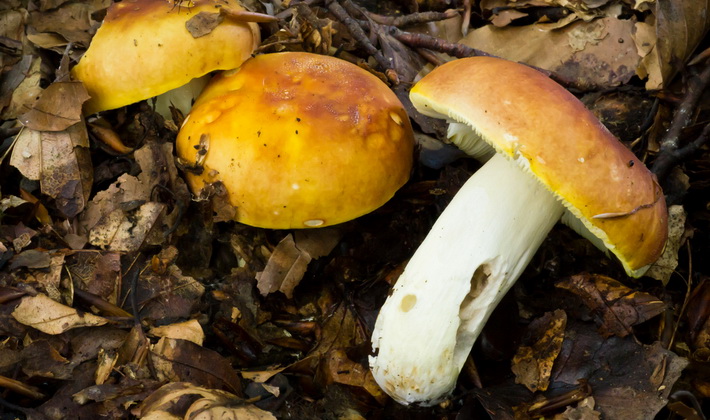
The cap is 5–9 cm in diameter, first hemispherical, convex, later convex-spread or flat, fleshy, depressed, with smooth or slightly ribbed edges. The hat is brighter at the edges. A distinctive feature of the species is the yellow-orange or yellow-red color of the hat.
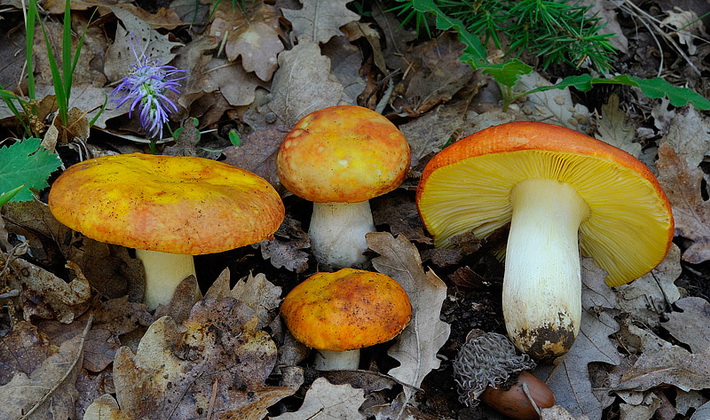
The foot is 5–9 cm high, 7–18 mm thick, cylindrical, even or slightly curved, initially dense, smooth, shiny, first white, then pale yellow or bright yellow.
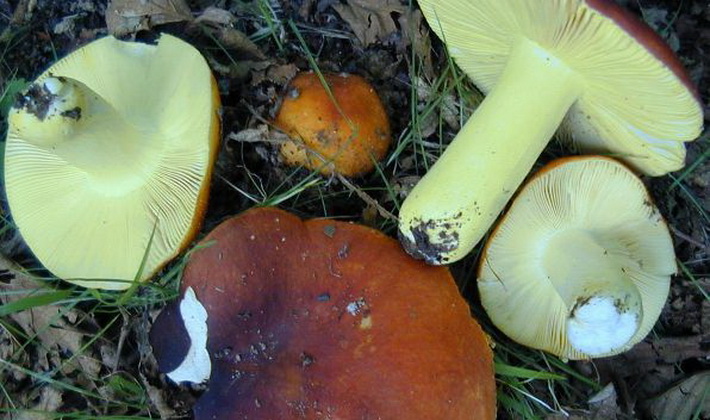
The pulp is cotton-like white, orange-yellow under the skin.
The plates are rare, grown, cream-colored with a yellow edge.
Variability. Over time, the color of the hat changes from light orange to yellow-red.
Similarity to other edible species. The Russula golden can be confused with the Russula claroflava (Russala claroflava), which is inedible and has a buffy-yellow hat with a greenish tint.
The difference from the poisonous pale toadstool (Amanita phallioides) with a variety with an olive-colored cap is that the pale toadstool has a ring on the leg and a bloated Volvo at the base.
Cooking Methods: frying, pickling, salting.
Edible, 3rd category.
Russula blushing false (Russula fuscorubroides).
Habitats: spruce and pine forests are found in groups or singly.
Season: July - October.
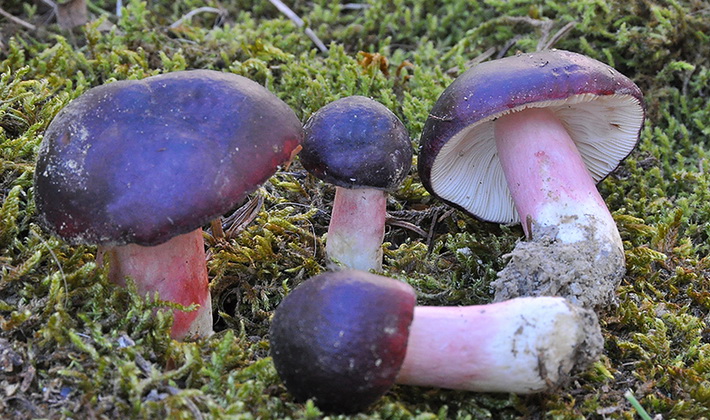
The cap is 4-10 cm in diameter, sometimes up to 14 cm, first hemispherical, later convex and prostrate, slightly depressed in the middle. The surface is initially sticky, later dry, velvety, without gloss, often with cracking edges. A distinctive feature of the species is lilac-purple or brownish-brown. The edges may be furrowed.
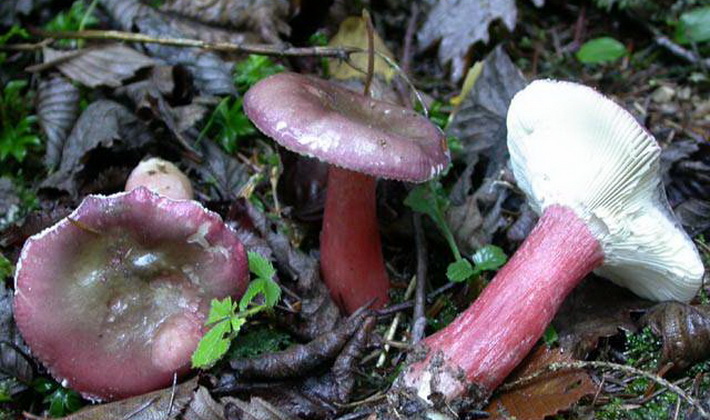
Leg 4–9 cm high and 7–15 mm thick, cylindrical, white, tapers slightly upward. The second distinguishing feature of the species is the purple color of the legs with rusty red grooves.
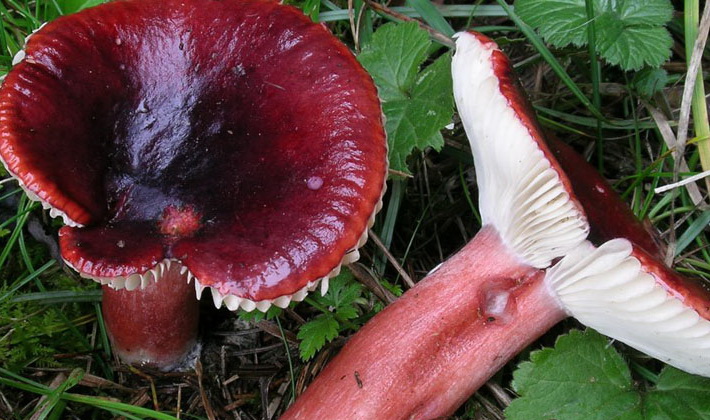
The flesh is a whitish-wine color with a fruity smell and a bitter taste.
The plates are frequent, narrow, adherent, arched, ocher-white.
Variability. The color of the hat eventually fades, fades, and in addition to the reddish hues, shades of yellow appear more and more.
Similarity to other edible species.The blushing Russula can be confused with Russula claroflava, which is also inedible and has a buffy yellow hat with a greenish tint.
Conventionally edible due to the bitter and slightly pungent taste. Used for cooking hot seasonings. The pungent taste is softened after cooking in 2-3 waters.
Russula azure, or blue (Russula azurea).
Habitats: spruce and pine forests are found in groups or singly. A rare species listed in the regional Red Books, status - 3R.
Season: July - September.
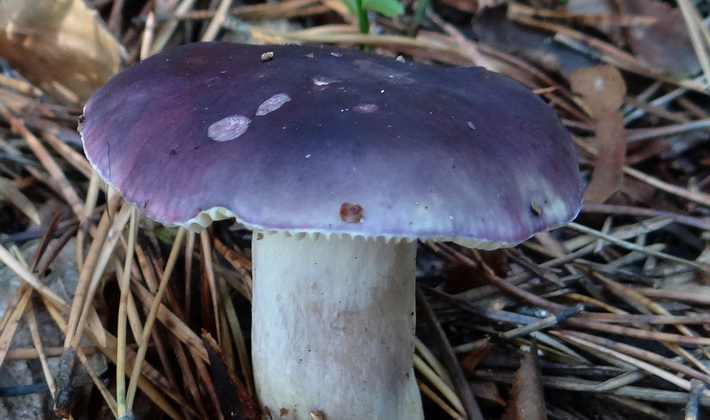
The cap is 4–8 cm in diameter, sometimes up to 10 cm, first hemispherical, later convex and prostrate, slightly depressed in the middle. A distinctive feature of the species is the uneven spotty bluish color of the hat.
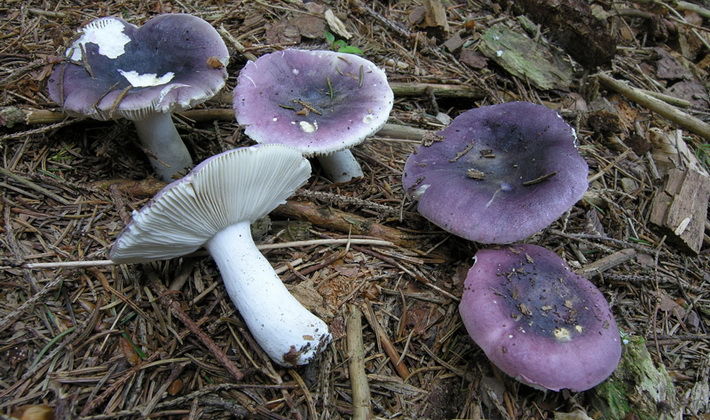
Leg 4–9 cm high and 7–15 mm thick, cylindrical, white.
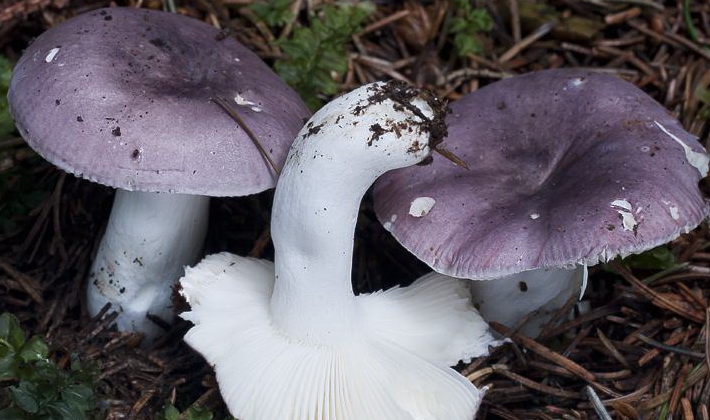
The pulp is whitish without much taste and smell. The plates are frequent, narrow, adherent, arched, first white, later ocher-white.
Variability. The color of the hat is uneven and has spots of blue and purple.
Similarity to other edible species. Russula Russula is similar to a good edible Russula blue-yellow (Russula cyanoxantha), which is distinguished by a blue-yellow or lilac color.
Similarity to poisonous species. There is a resemblance to the green form of the pale grebe (Amanita phalloides, f. Gummosa), which has a large ring on the stem and a Volvo at the base.
Edible, 3rd category.
Russula husky (Russula alutacea).
Habitats: oak and broad-leaved mixed forests, less often in coniferous forests, grow singly, but more often in small groups.
Season: July - September.
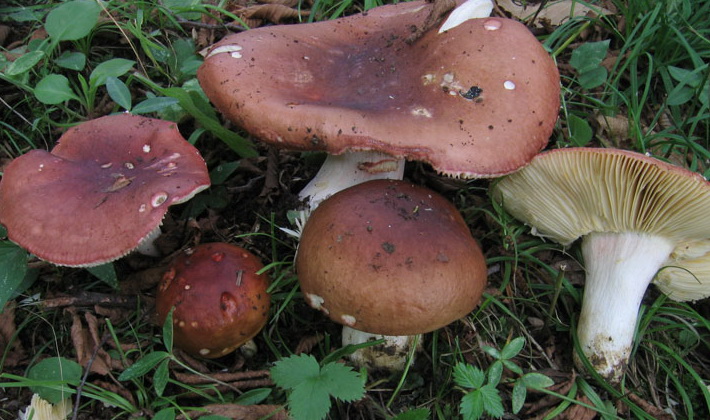
The cap is 4-10 cm in diameter, sometimes up to 15 cm, first hemispherical, later convex and prostrate, slightly depressed in the middle. The hat is sticky at first, later matte. A distinctive feature of the species is a pink-red hat with a tan middle and a thinly tuberous edge.
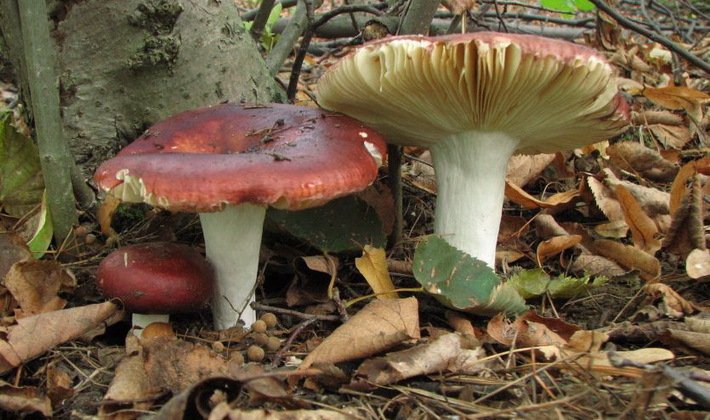
Leg 4-8 cm tall and 7-25 mm thick, cylindrical, slightly narrowed at the base, dense, fleshy.
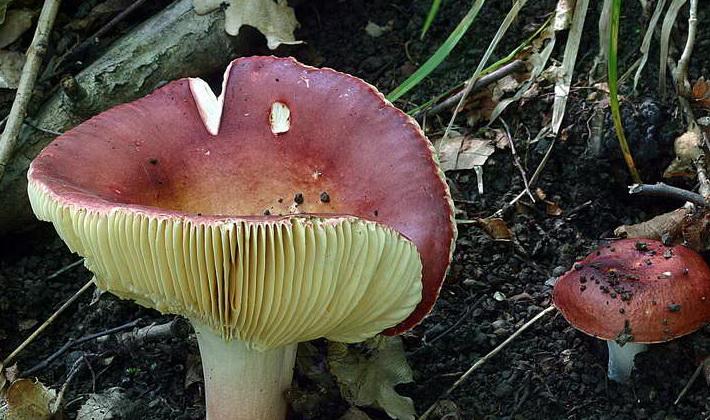
The pulp is dense, yellowish under the skin, first white, then reddish. The pulp has a pleasant fruity smell and a pleasant nutty taste.
Medium frequency discs, whitish or cream, later yellowish pink.
Variability. The color of the hat can vary from pink-red to bright red with a yellowish-olive middle.
Similarity to other edible species. The russula is similar to the russula (Russula rosea), which is distinguished by the even pinkish-red color of the hat.
Similarity to poisonous species. There is a resemblance to a yellow fly agaric (Amanita gemmata), which is distinguished by the presence of a wide ring on the stem and a volva at the base.
Edible, 3rd category.
Russula lilac (Russula lilaceae).
Habitats: mixed forests, rare species.
Season: July - September.
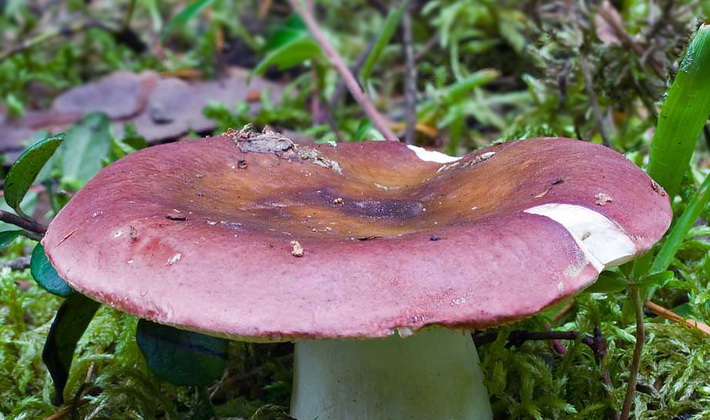
The cap is 4-10 cm in diameter, first hemispherical, later convex and prostrate, depressed in the middle. The surface is initially sticky, later dry, slightly shiny. A distinctive feature of the species is the lilac-pink color of the hat with a lighter middle.
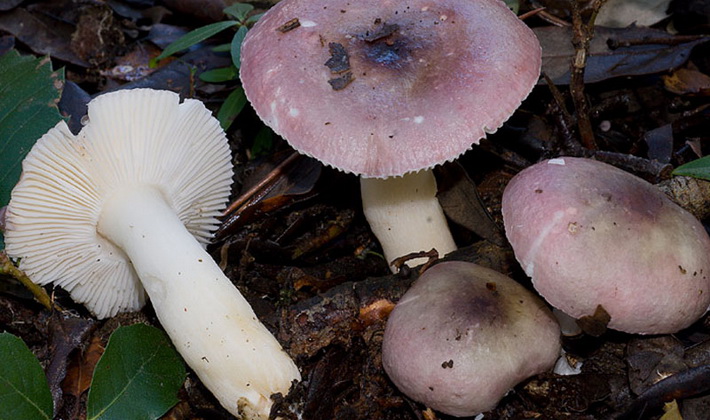
Leg 4-7 cm high and 7-20 mm thick, white, cylindrical or slightly club-shaped.
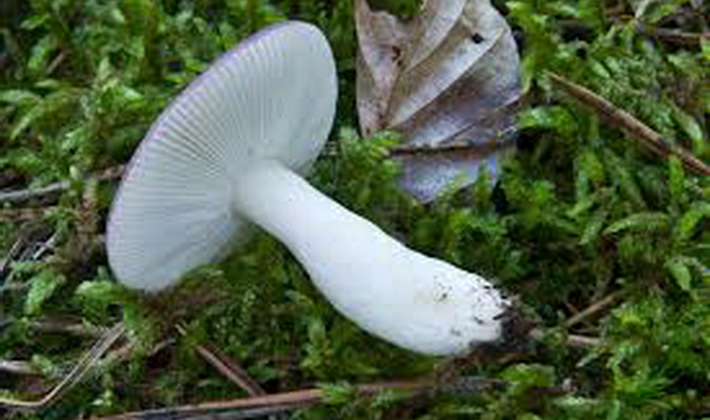
The pulp is white.
The records are very frequent, colors. The spores are white.
Variability. The color of the hat can vary from lilac-pink to lilac-brown.
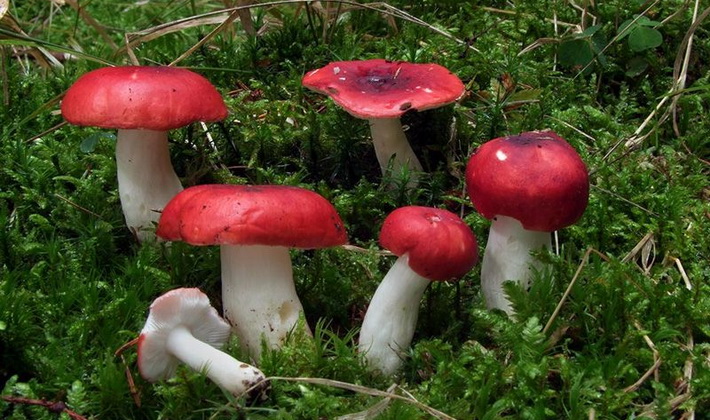
Similarities to other species: Russula lilac in color similar to the inedible russula is pungent-caustic (Russula emitica), which is distinguished by light cream plates and a pinkish leg.
Edible, 4th category.
Russula Mayra (Russula Mairei).
Habitats: mixed and coniferous forests, grows both in groups and individually.
Season: July - September
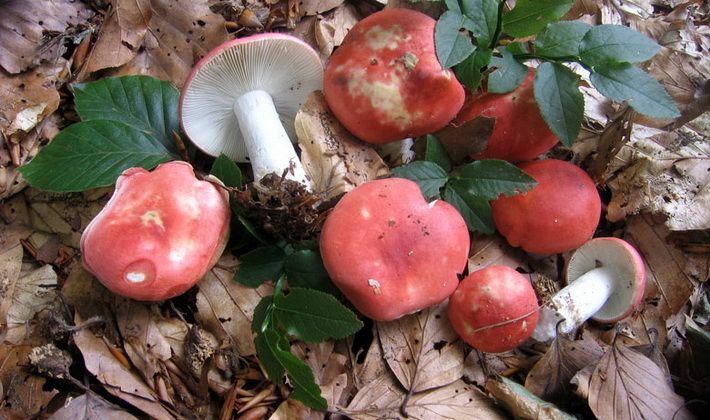
The cap is 3-7 cm in diameter, sometimes up to 12 cm, first hemispherical, later convex and prostrate, depressed in the middle.The surface is dull, dry, in wet weather it becomes sticky. A distinctive feature of the species is its bright scarlet color. The center of the hat has a darker shade.
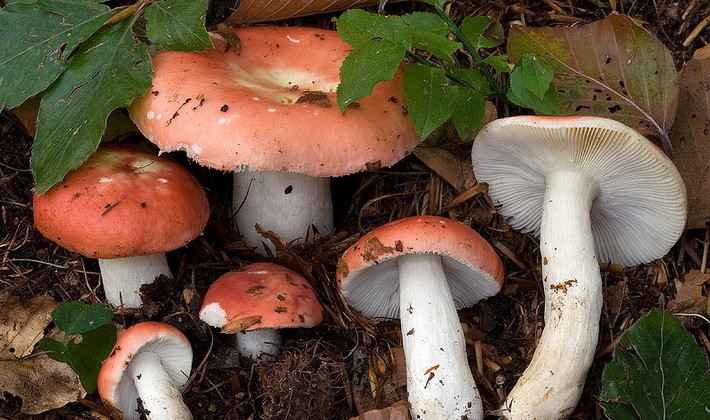
Leg 3-8 cm tall and 0.7-1.5 cm thick, smooth, white, first expanded at the base, later cylindrical, turns yellow with age or has a pinkish-red tint
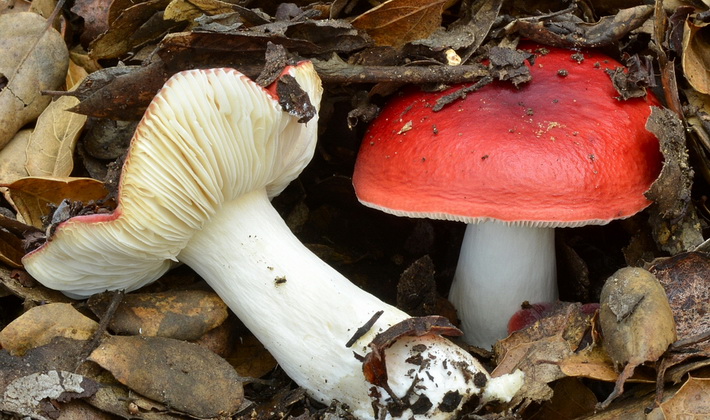
The pulp is dense, brittle, white. The second distinctive feature of the species is the smell of honey or coconuts in the pulp. With age, the smell becomes sweetish.
The plates are thick, white, with a slight gray-green tint.
Variability. With age, the main bright scarlet color fades and a pinkish tint appears for the entire surface and brownish in the middle.
Similarity to other edible species.
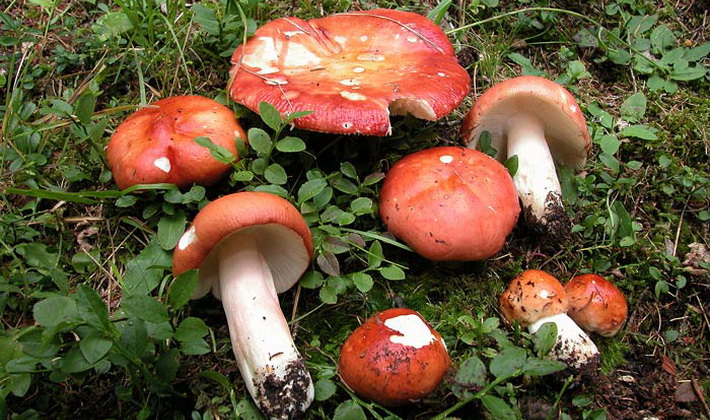
Maira Russula can be confused with an edible swamp russula (Russula paludosa), in which the hat is orange-red with a yellowish center, the leg is white with a pinkish tint and has a pleasant taste and almost odorless.
Toxic due to a very bitter and pungent taste. Mushrooms with a single boil cause nausea.
Russula olive (Russula olivaceae).
Habitats: mixed and coniferous forests, grows both in groups and individually.
Season: July - September.
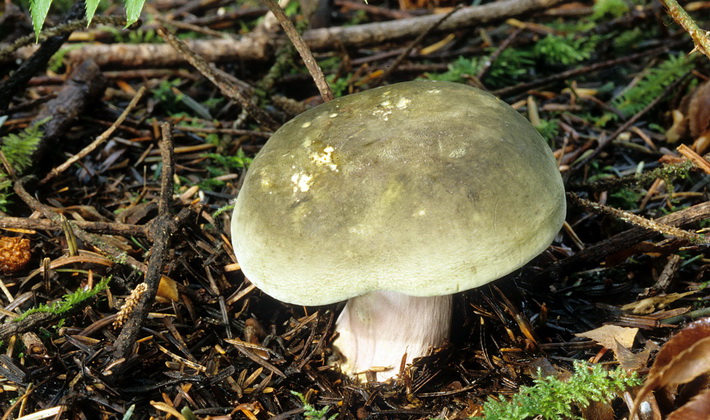
The cap is 4-10 cm in diameter, sometimes up to 15 cm, first hemispherical, later convex and prostrate, depressed in the middle. The surface is dull, dry, in wet weather it becomes sticky. A distinctive feature of the species is an olive-pink or olive-brown hat with a darker middle. The edges of the caps have ribbed edges and are lighter in color.
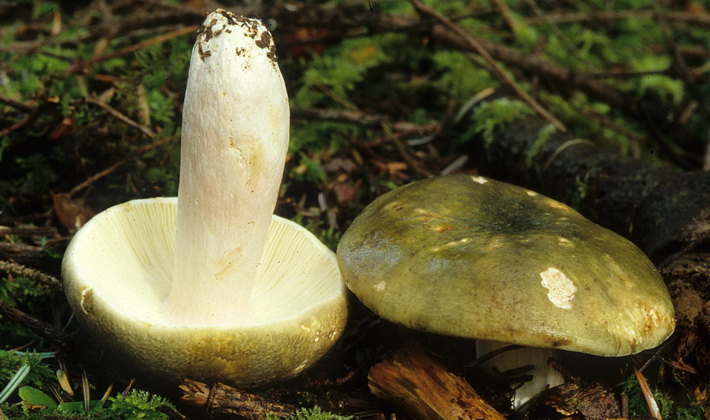
Leg 4-8 cm tall and 7-20 mm thick, smooth, white, initially club-shaped and dense, later cylindrical, slightly yellowing with age.
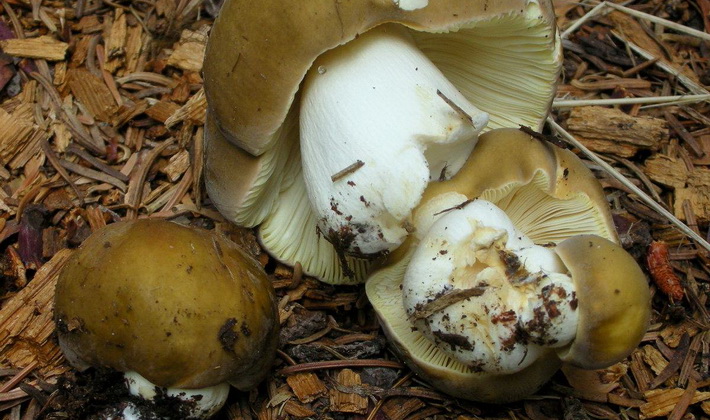
The pulp is dense, fleshy, first white, later yellowish, brown at the cut, without any special smell.
Variability. The color of the hat varies from olive pink to olive brown.
The plates are frequent, fragile, adherent with a tooth, first white, later yellowish.
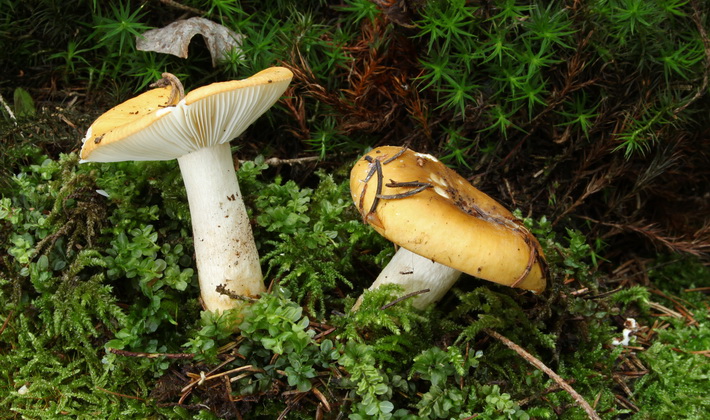
Similarity to other species. Russula olives similar to conditionally edible with pepper taste Russula ochroleuca (Russula ochroleuca), in which the hat is ocher-yellow.
The difference from the hue of a poisonous fly agaric (Amanita gemmata), which is similar in tone to the hat, is that the fly agaric has a wide ring on its leg, and a whitish Volvo at the base.
Cooking Methods: make soups, stew, fry, salt.
Edible, 3rd category.
Russula purplish brown (Russula badia).
Habitats: boggy coniferous and deciduous forests grow in groups or singly.
Season: July - September.
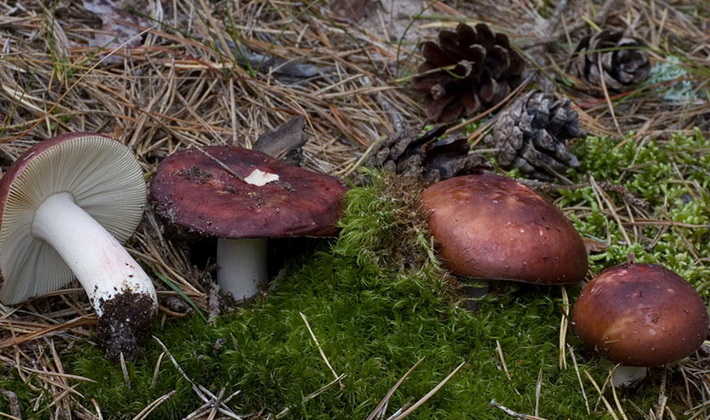
The cap is 4-10 cm in diameter, sometimes up to 12 cm, first hemispherical, later slightly convex with lowered edges, with a wavy, sometimes serrated edge. The surface in wet weather is slightly sticky, in other weather - dry. A distinctive feature of the species is the purple-brown color of the hat. The central area of the hat has a darker burgundy hue.
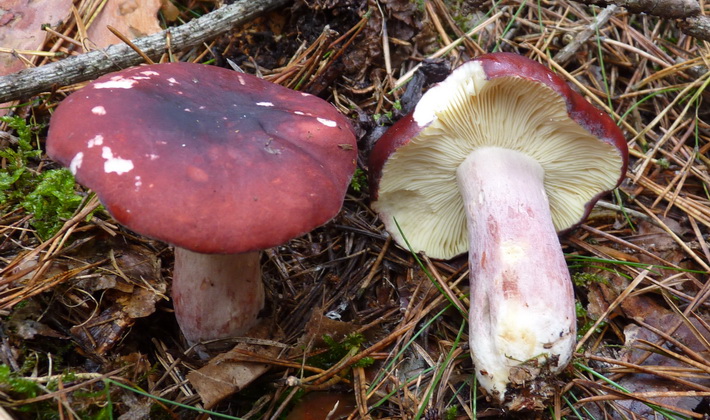
Leg 4-10 cm tall and 8-20 mm thick, cylindrical, dense, slightly widened to the base.
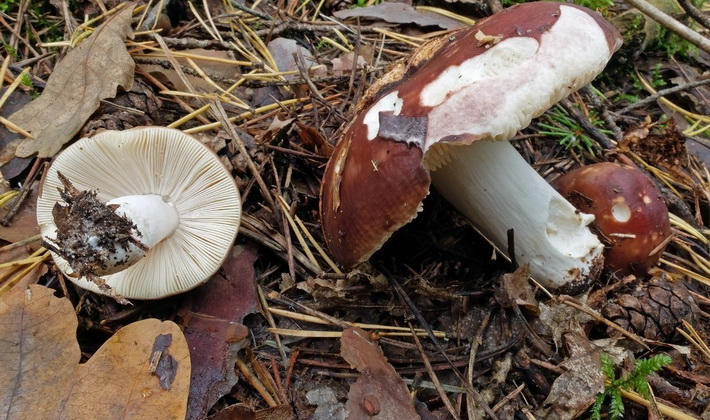
The pulp is white, with a pleasant soft, pungent taste.
The plates in young specimens are white, later with a yellowish-pinkish tinge. Cream spore powder.
Variability. The color of the hat is variable: from purplish brown to burgundy.
Similarity to other species. The purple-brown russula can be confused with the inedible, pungent-caustic russula (Russula emitica), which has a red, pink-red, or purple-colored hat on the entire area, the leg is pinkish in places, the flesh is white, under the skin it is pinkish with a very burning taste.
Ways to use: pickling, pickling, frying
Edible, 4th category.
Russula blue-yellow (Russula cyanoxantha).
Habitats: pine, birch and mixed forests, in groups or singly.
Season: June - October.
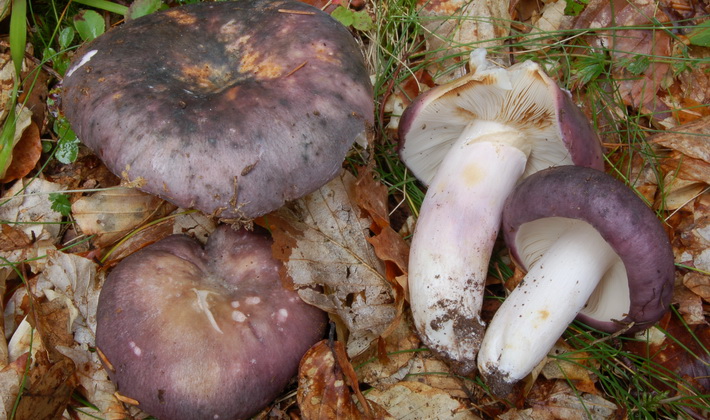
Hat with a diameter of 5-15 cm, first convex, hemispherical, then prostrate, almost flat with a concave middle, hard and thick.A distinctive property of the species is the main blue-yellow, blue-green, lilac color. In young specimens, the skin is sticky, in old ones - dry, often wrinkled, radially fibrous with a thin ribbed edge. The peel is removed on most of the cap.
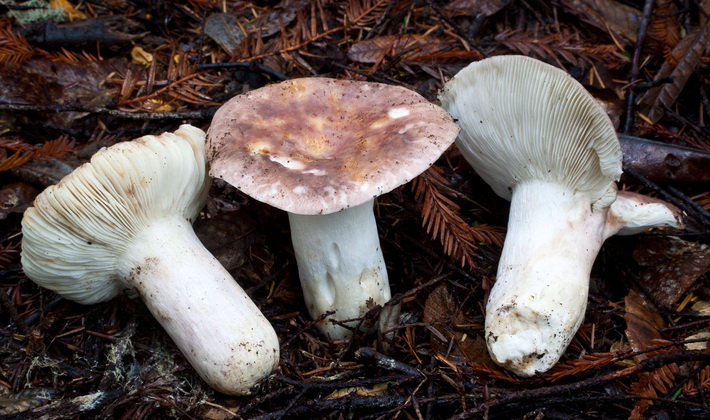
Leg 5-11 cm tall, 1-3 cm thick, cylindrical, white, with reddish spots, first dense, later hollow, smooth, white.
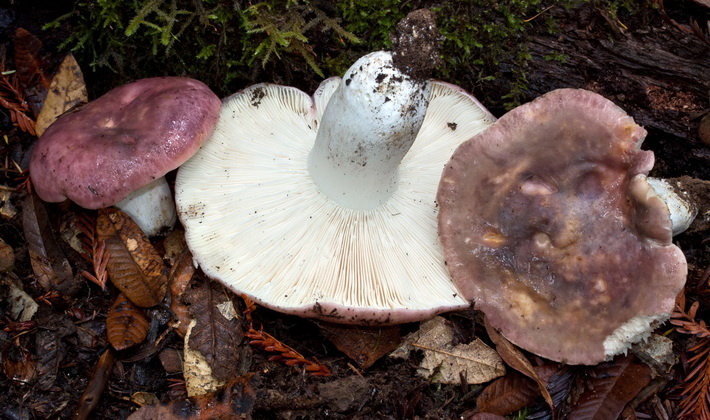
The pulp is white, purple-reddish under the skin, strong, with a cotton-like stem in the leg, with a soft mushroom taste, without any special smell.
Lamellae 0.5-1 cm wide, frequent, grown, flexible, sometimes fork-branched, silky, white or creamy white. Spore powder is white.
Variability. This species is characterized by a strong variety of colors and color zones. The hat is enriched over time with tones of purple, gray, brown, along with the main blue-yellow and blue-green.
Similarity to other species. Russula blue-yellow can be confused with Russula fragilis (Russula fragilis), in which the hat is brown-lilac, purple-red, club-shaped leg, white-cream plates, brittle flesh, with a pungent and bitter taste.
Cooking Methods: this species is one of the most delicious among russula, they are pickled, salted, fried, put in soups.
Edible, 3rd category.
Russula turkish (Russula turci).
Habitats: pine, spruce and mixed forests, grow in groups or singly.
Season: July - October.
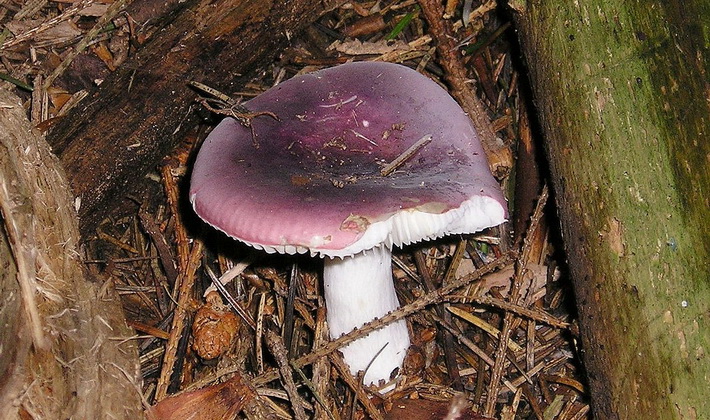
Hat with a diameter of 5-15 cm, first convex, hemispherical, then prostrate, almost flat with a concave middle. In wet weather, the surface is sticky, in another it is dry and felt. A distinctive feature of the species is a wine-red or brown-rusty color. In the middle, the hat has dark shades of brown and black.
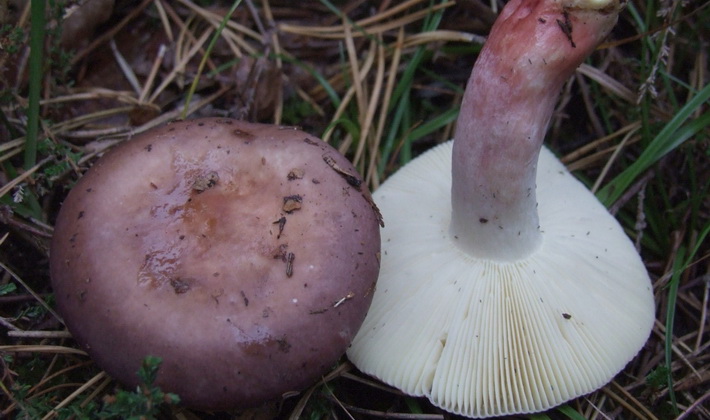
The leg has a length of 5-12 cm, a thickness of 1-2.5 cm, it is white in color, club-shaped, at the base has the smell of iodoform.
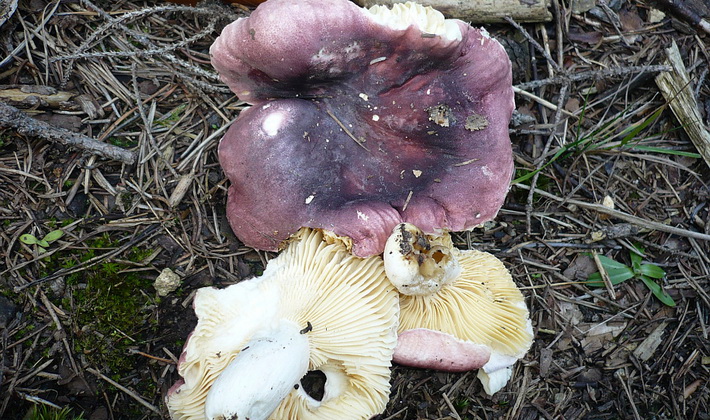
The pulp is brittle, white.
The plates are rare, grown, first white, and as they ripen, they are buffy with a fruity smell.
Variability. The color of the hat varies from brown or wine brown to dirty brick or reddish brown.
Similarity to other edible species.Turkish russula can be confused with food russula (Russula vesca), in which the hat is lighter: light wine-brown with a brown tint, whitish leg with rusty specks, and the flesh is almost odorless.
Cooking Methods: pickling, salting, frying.
Edible, 4th category.
Wake
Volnushki, like other milkers, are first soaked and then prefabricated. With good brine and spices, delicious and crispy mushrooms are obtained.
White whisker (Lactarius pubescens).
Habitats: deciduous and mixed forests, in meadows, near country roads, grow in groups or singly.
Season: July - September.
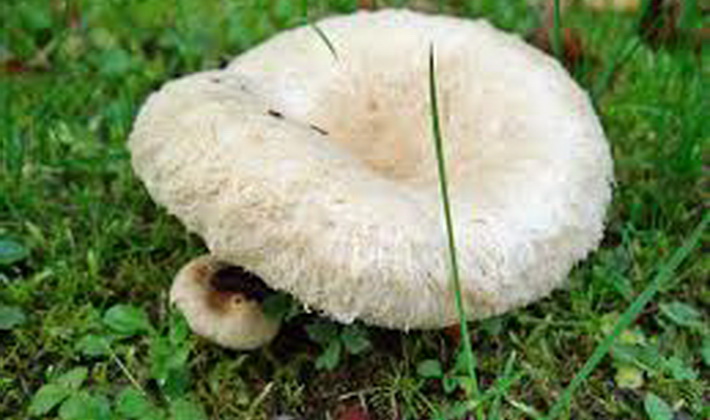
A hat with a diameter of 3-7 cm, first convex, later prostrate, flat, concave in the middle. A distinctive feature of the species is the furry edge, strongly furled downwards, a fluffy-silky surface and a white or white-cream-colored hat, in the middle pinkish-fawn. There are no concentric circles or they are very poorly visible.
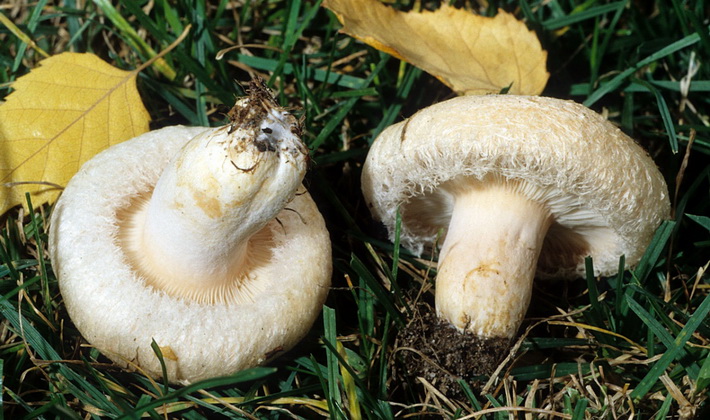
Leg 3-6 cm tall, 7-20 mm thick, cylindrical, fine-fluffy, white or light pinkish.
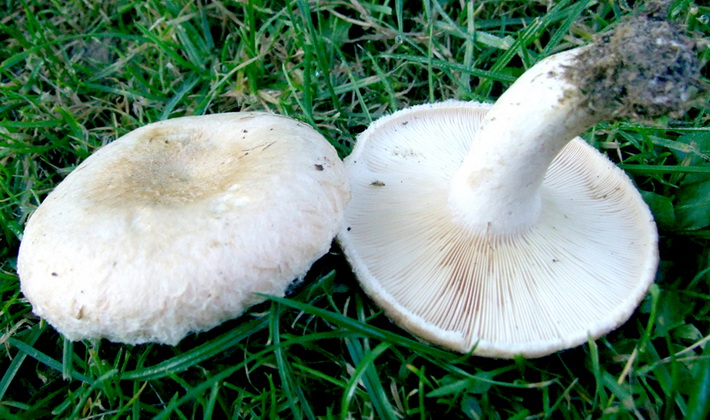
The pulp is white, pinkish under the skin. Milky juice is white, caustic, not changing color in the air.
The plates are grown or slightly descending along the pedicle, frequent, narrow, pale yellow, white, or creamy pink. Cream spore powder.
Variability. The color of the hat can vary from white to gray or cream.
Cooking Methods: salting after pretreatment by boiling or soaking.
Edible, 4th category.
Pink Wax (Lactarius torminosus).
Habitats: pine and mixed forests with a predominance of pine, grow in young plantings in groups.
Season: September - November.
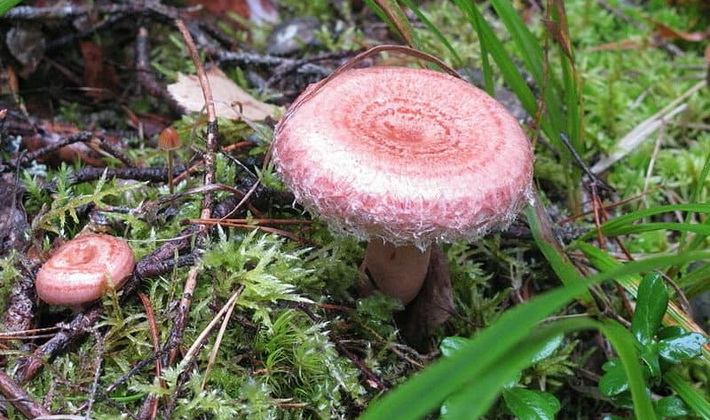
A hat with a diameter of 4-12 cm, sometimes up to 15 cm, is initially convex, with an open prostrate. In the middle a little concave.A distinctive feature of the species is a woolly-fibrous surface and strongly curved fluffy edges, as well as a reddish-pink color of the hat with distinct concentric zones in color.
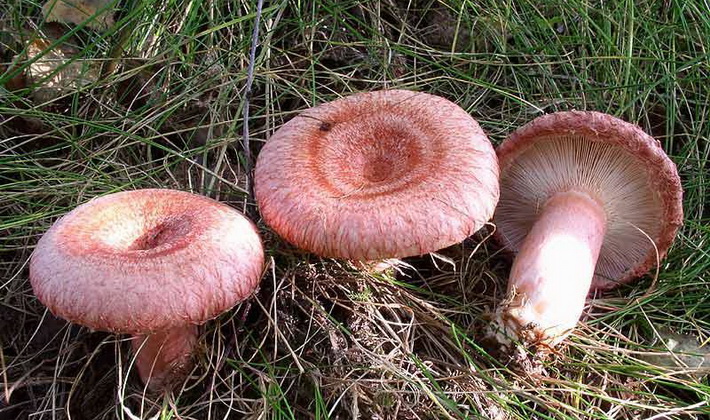
Leg 4-8 cm tall, 0.7-2 cm thick, cylindrical, initially solid and fine-fluffy, later hollow and olive-brown, in young mushrooms with a mucous ring, which then disappears, even or narrowed downwards.
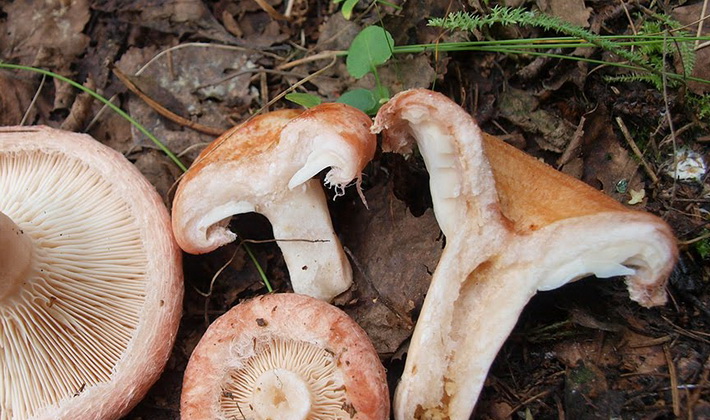
The flesh is white, sometimes yellowish, friable, pinkish at the hat, darker in the leg. At the break, the color does not change, with a slightly resinous odor. Milky juice is plentiful, white, colorless, burning, caustic.
Plates 0.3-0.4 cm, arcuate, descending or overgrown, thick, rare, waxy, yellowish or light yellow. Spore powder is white.
Similar views. The pink top is similar to the delicious saffron milk cap (Lactarius deliciosus), which has a similar color - yellow-orange with a greenish tint, but there is no such hairiness and silkiness of the surface. In addition, in saffron milk, the flesh on the slice turns green.
Cooking Methods: salting after pretreatment by boiling or soaking.
Edible, 4th category.
What other mushrooms grow in August
Spurge
Brightly colored milkweed, as well as other milkers, are first soaked and then prefabricated. With good brine and spices, delicious and crispy mushrooms are obtained.
Euphorbia or submilk (Lactarius volemus).
Habitats: mixed and deciduous forests, grow in groups or individually.
Season: August - October.
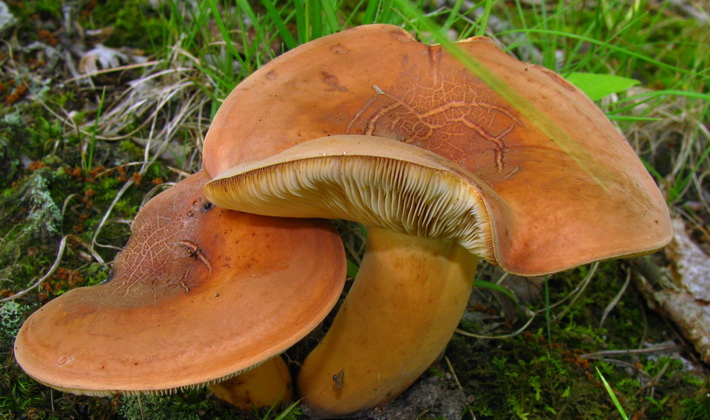
The hat has a diameter of 4-12 cm, sometimes up to 20 cm, first convex with the edges bent down and a small indentation in the center, later spread out with a depressed middle, fleshy, covered with a thinly hairy coating, smooth, but sometimes cracked. A distinctive feature of the species is a bright orange-brown, red-brown, reddish-brown color of the hat and legs and yellowish plates. The edges are bent down and lighter.
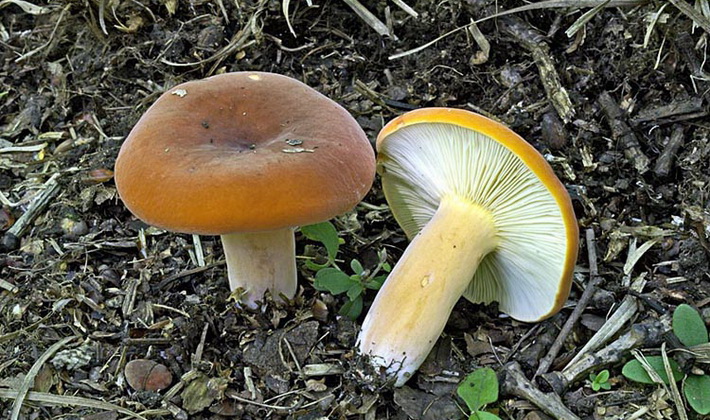
The leg is 4-12 cm high, 1-3 cm thick, lighter than the cap, cylindrical, even, dense, one-color with the cap; with age, the leg becomes hollow. In the upper part, the leg is lighter.
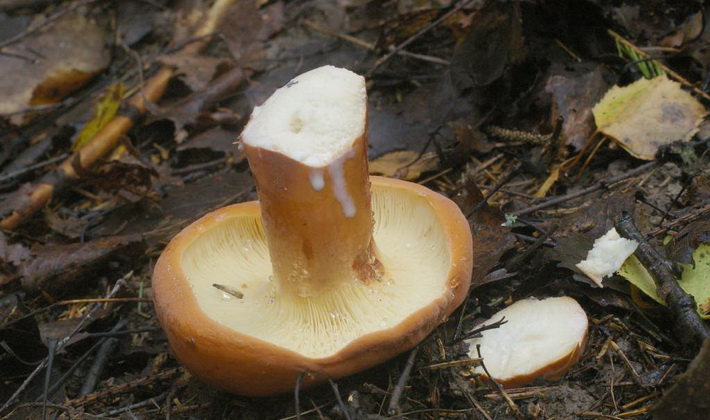
The pulp is white, dense, turns brown at the break. The second distinctive feature of the species is a plentiful white milky juice, which turns brown in air. The taste is pleasant, it has the smell of crabs or herring, in old mushrooms the taste and smell are unpleasant.
Lamellae 0.4-0.7 cm wide, frequent, thin, adhering to the leg or descending along it, yellowish or whitish, brownish in old mushrooms, and brown with touch and age. Spores are warty, light ocher. Spore powder is light ocher.
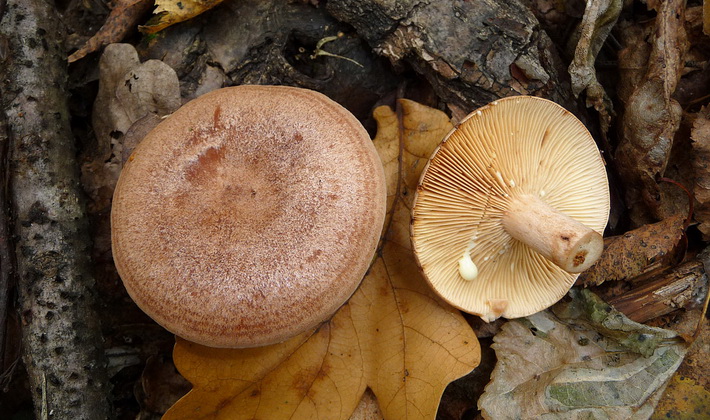
Similarity to other species. Euphorbia is confused with a neutral lactarius (Lactarius quietus), which is conditionally edible and tastes significantly inferior to milkweed. The neutral milky has a yellowish rather than white milky juice, which does not change color in the air and has no herring smell.
Cooking Methods. A delicious mushroom that is dried, fried, pickled, salted, but only young specimens.
Edible, 3rd category.
Polish mushroom (Boletus badius).
Polish mushrooms are widely represented in forest areas of Russia. Often, mushroom pickers classify them as boletus or ceps. In terms of utility and taste, the difference is small. Polish mushrooms grow near forest paths, on the border of forest zones and on the border of trees and clearings.
Habitats: grows in coniferous and mixed forests, mainly on acidic soil, but occurs at the base of trunks and stumps.
Season: July - September.
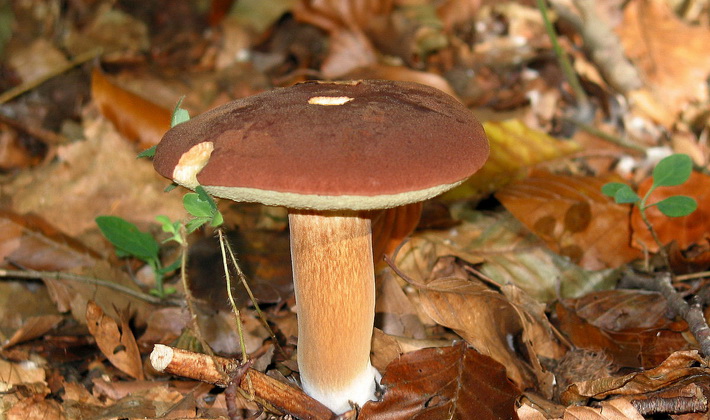
The hat is convex 5-12 cm, but can be up to 18 cm. A distinctive feature of the species is the smooth, oily, leathery surface of the hat with a chestnut-brown, dark brown, and brown-brown color. The surface is sticky, mucous, especially in wet weather. The edge of the hat is flat.
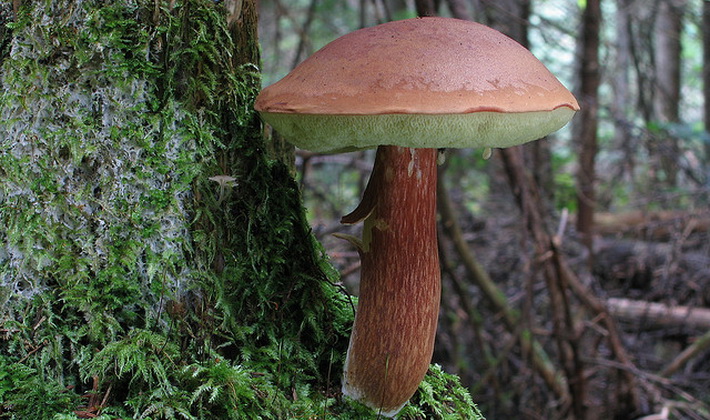
The leg is dense, cylindrical, to the base or narrowed, or slightly swollen, 5-10 cm high, 1-4 cm thick.The leg is smooth, light brown, without a mesh pattern, usually lighter than a hat.
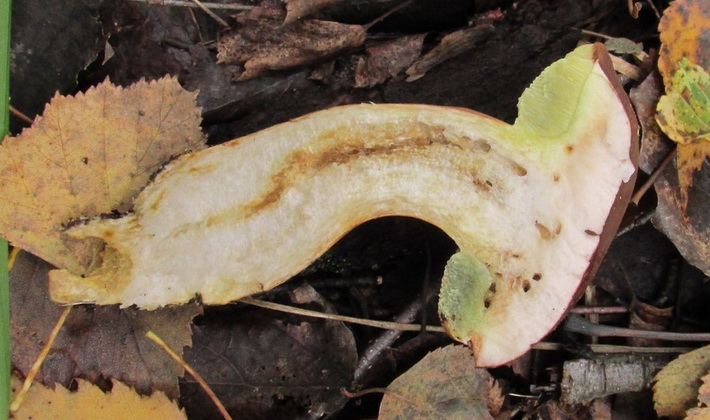
The pulp is white or pale yellow, turning blue. Spore powder is brownish-olive.
The tubular layer, grown or matured is almost free, lagging behind the peduncle. The surface of the tubular layer with medium sized pores is pale yellow or gray-yellow, when pressed, it gradually turns blue-green.
Variability: the hat becomes dry and velvety over time, and the color of the hat changes from brown to chocolate and dark brown. As the mushroom ripens, the cap's skin can shrink, exposing the surrounding ducts. The color of the legs varies from light brown and tan to reddish brown.
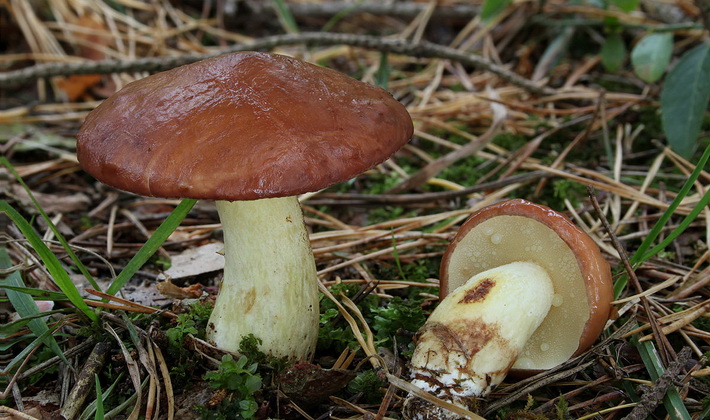
There are no poisonous doubles. Polish mushroom is similar to an edible granular oiler (Suillus granulatus), characterized by a sticky hat with a lighter yellow-orange tint.
The property of accumulation of harmful substances: this species has the property of strong accumulation of heavy metals, so you should clearly observe the conditions for collecting mushrooms in an area no closer than 500 meters from highways and chemical plants.
Cooking Methods: dried, canned, stewed, prepared soups.
Edible, 2nd category.
Chestnut mushroom (Gyroporus kastaneus).
Chestnut mushroom is found much less frequently than the Polish mushroom and is listed in the Red Book in a number of regions. They are also tubular and taste like young mushrooms. They also grow near forest paths, not far from spruce and birch roots.
Habitats: grows in deciduous broadleaf and mixed forests, often on sandy soil next to oaks. Mushrooms are listed in the Red Book of the Russian Federation and regional Red Books. Status - 3R (rare species).
Season: end of June - end of September.
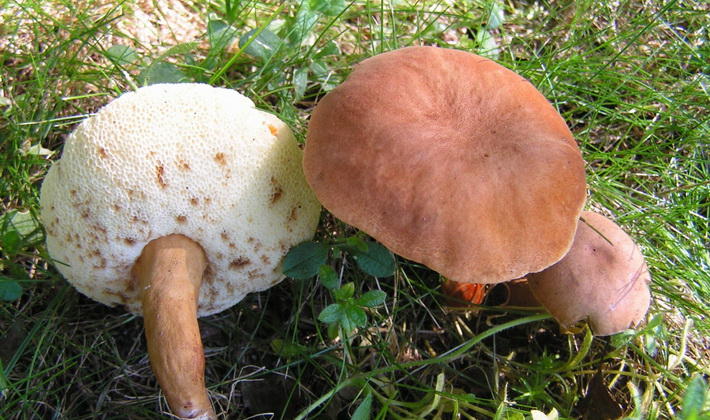
The hat is convex 4-10 cm, has a smooth, velvety surface of orange-brown, chestnut, reddish-brown color. The edge of the hat is flat. Over time, the hat becomes flat and the edges can rise up.
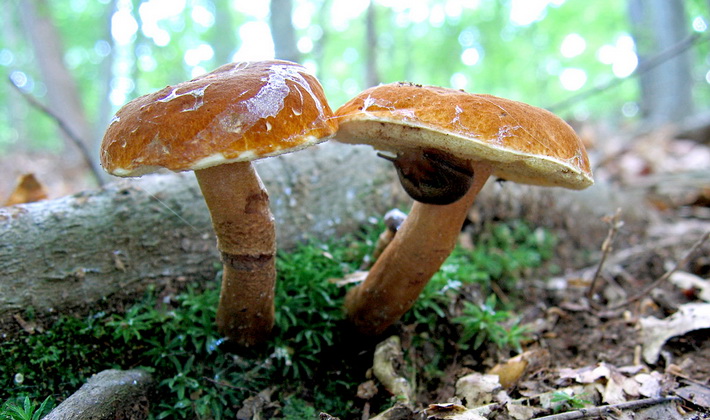
The leg is cylindrical, light orange, 5-8 cm high, 1-3 cm thick. The leg inside is hollow.
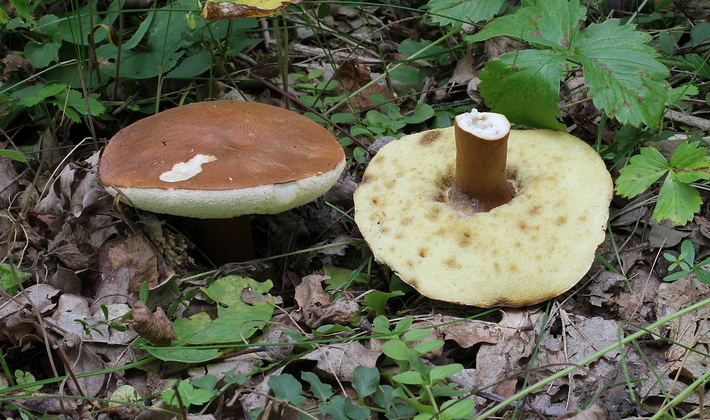
The flesh is yellowish, with a pleasant nutty taste and smell.
The tubular layer, grown or matured is almost free, lagging behind the peduncle. The surface of the tubular layer with medium sized pores is pale yellow or gray-yellow, when pressed, it gradually turns blue-green.
Variability: the hat becomes dry and velvety over time, and the color of the hat changes from chestnut to dark brown. As the mushroom ripens, the cap's skin can shrink, exposing the surrounding ducts. The color of the legs varies from light brown and tan to reddish brown.
There are no poisonous doubles. The chestnut mushroom is similar to the Polish mushroom (Boletus badius), which differs not in a velvety, but in a smooth oily hat.
Cooking Methods. Although the mushroom is edible, but since it is listed in the Red Book, its collection is prohibited, and it needs protection.
Edible, 2nd category.
Bruise (Gyroporus cyanescens).
Mushrooms bruises are dramatically different from everyone else. They will turn blue quickly when cut or broken. This indicates a high content of iron compounds, which is useful for individual patients. In the Central European part of Russia, they grow in fern glades near mixed forests. They are very pleasant and tender to taste.
Habitats: grows in mixed and deciduous forests. The bruise is listed in the regional Red Books, status - 3R (rare species).
Season: June - October.
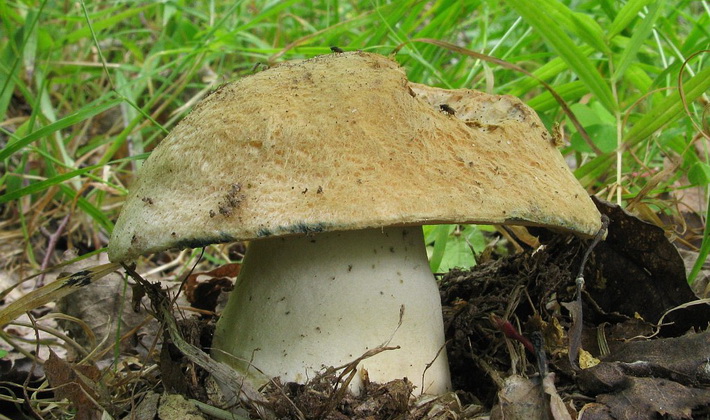
A hat with a diameter of 3-8 cm, but sometimes up to 10 cm, hemispherical. A distinctive feature of the species is a thin-velvety soft surface, a yellow-pink or creamy-pink hat with cornflower spots in the places of damage.
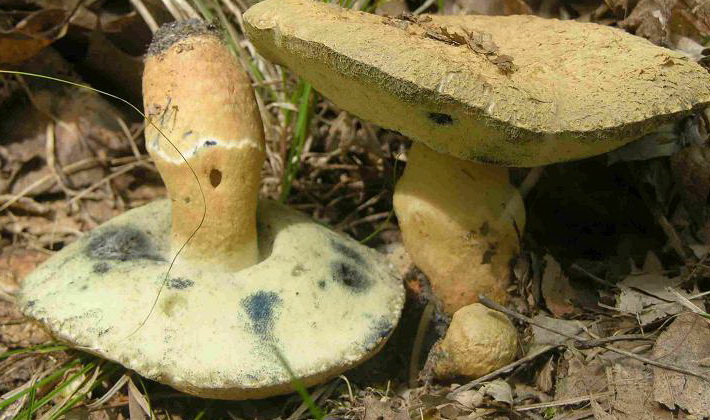
The leg is thin, yellow, smooth, brittle, often with cavities, 4–9 cm high, 10–25 mm thick, the same color as the hat. The base of the leg is slightly thickened, and at the end it is slightly pointed.
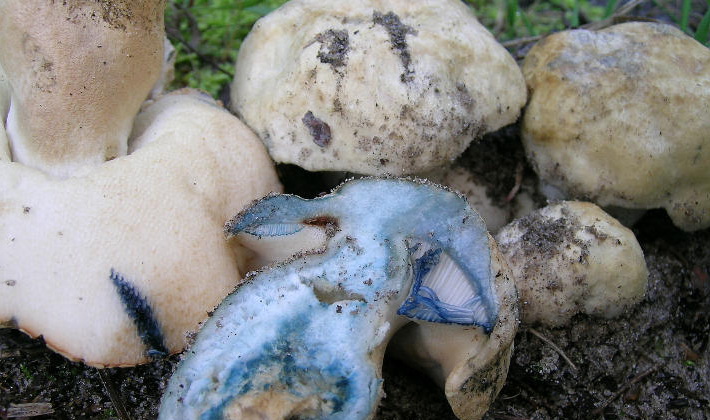
The pulp is brittle, creamy white with a nutty flavor.The second distinctive feature of the species is the cornflower blue or bluish color of the pulp at the cut or fracture.
The pores of the tubular layer are clearly visible. Tubules adhered, descending, 0.3-1 cm high, yellow or olive-yellow in color with large angular pores of olive-green color.
The hymenophore has grown, the color may be white or straw yellow.
Variability. Color can range from yellowish fawn to creamy pink.
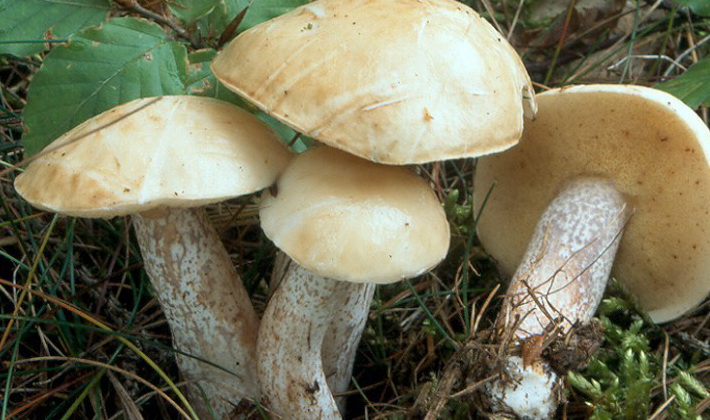
There are no poisonous doubles. Outwardly similar is a white oiler (Suillus placidus), which although the color of the hat and legs is similar, it does not appear blue or cornflower blue at the break or slice.
Cooking Methods. Although the mushroom is edible and has a pleasant nutty taste, but due to its rarity and inclusion in the Red Book it is subject to protection and protection.
Edible, 3rd category.
Pepper Mushroom (Chalciporus piperatus).
Habitats: in dry coniferous and mixed forests. Forms mycorrhiza with hardwood. It grows singly or in groups.
Season: July - October.
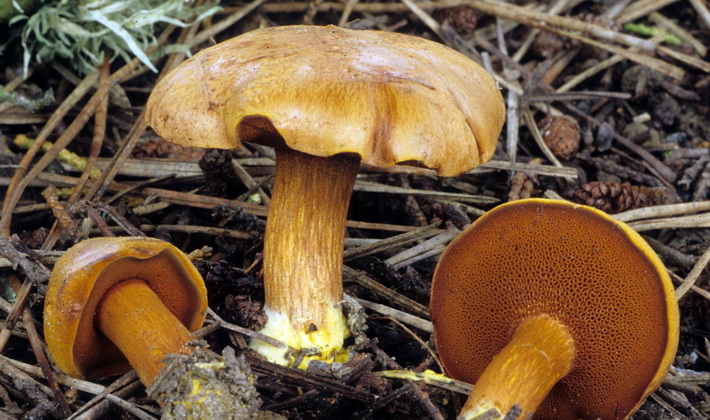
Hat 3-8 cm in diameter. A distinctive feature of the view is the copper-red or dark rusty color of the hat. Its shape is round-convex, then convex-prostrate or almost flat. The surface is dry, slightly velvety. In wet weather, the hat is mucous, in shiny shiny.
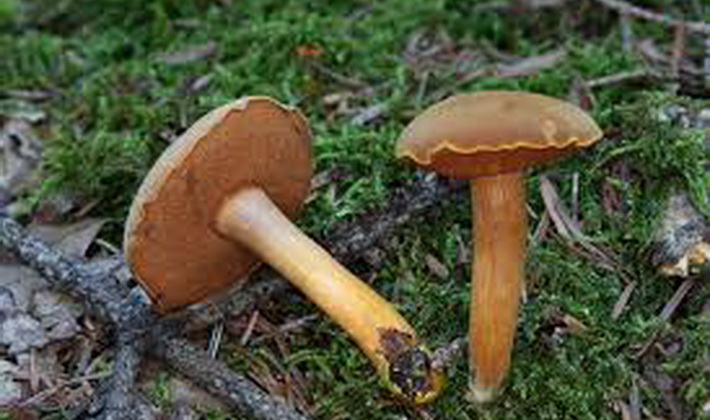
The leg has a length of 4-8 cm, a thickness of 0.7-1.5 cm. It is smooth, cylindrical, solid, often curved and can be slightly narrowed from the bottom. The second distinctive feature of the species is the color of the legs as unusual as the hat.
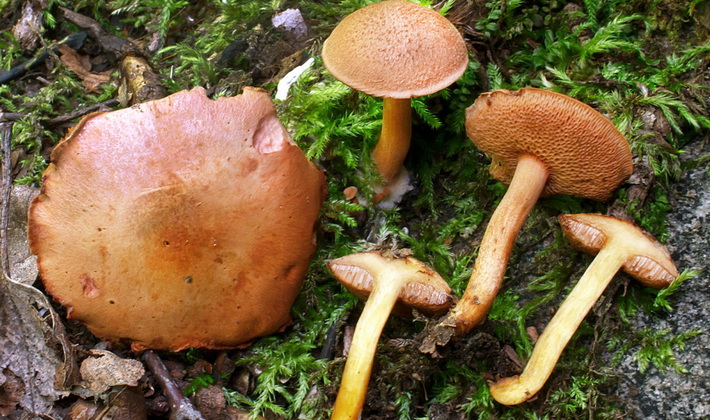
The pulp is friable, sulfur-yellow, when pressed, it acquires a bluish tint. The taste is very sharp, peppery, the smell is weak.
The tubular layer adhered to the pedicle and slightly descends along it. The tubes are the same color as the hat, when touched they get a dirty brown color. The pores are uneven, large and angular. Spore powder is yellow-brown.
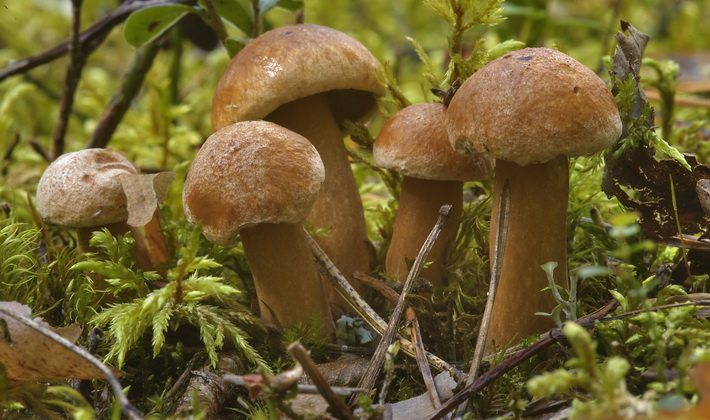
There are no poisonous doubles. Pepper mushroom is similar in shape and color to an edible goat (Suillus bovines), in which the flesh is pinkish, odorless and tasteless.
Conventionally edible, as they have a sharp pepper taste, which decreases during cooking in 2-3 waters, is used only for hot seasonings.
Smoothen, or common lactarius (Lactarius trivialis).
Habitats: moist deciduous and coniferous forests grow most often in groups.
Season: August - October
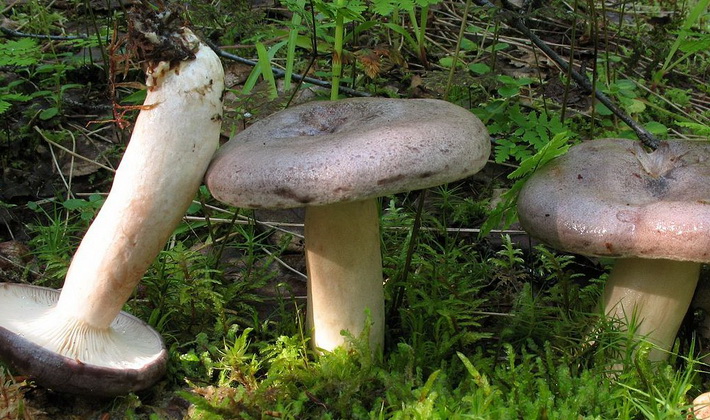
Hat with a diameter of 5-15 cm, sometimes up to 25 cm, fleshy, smooth, slimy, convex, with sharply turned down edges and with a recess in the center, later flat or funnel-shaped. A distinctive feature of the species is a sticky lead-gray hat with a purple hue, later gray-yellow, reddish-brown, reddish-brown with barely noticeable concentric circles or without them.
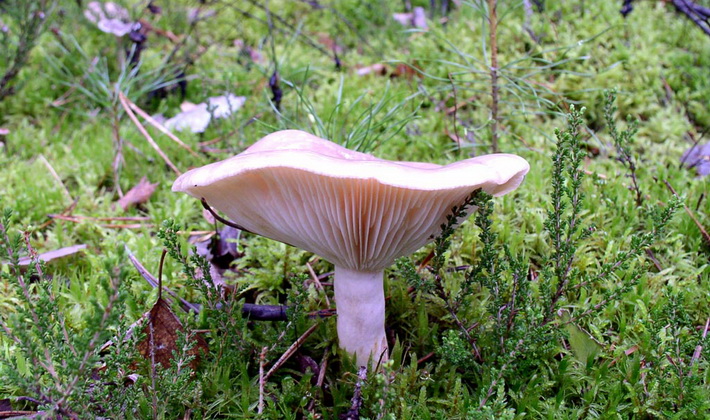
Leg 6-9 cm long, 1-3 cm thick, dense, hollow, smooth, sticky, yellowish or of the same color with a hat.
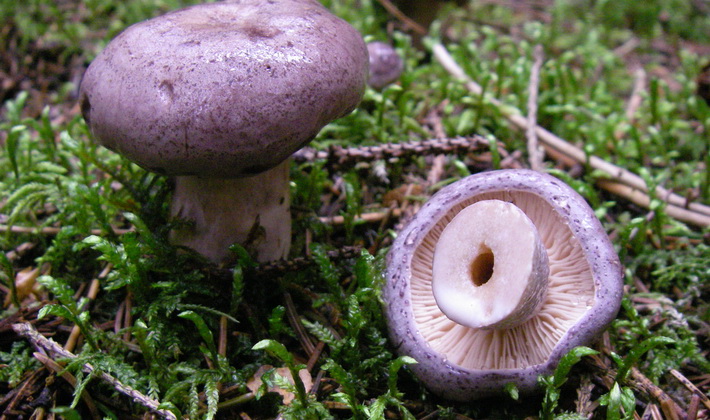
The pulp is white or slightly creamy, very fragile, soft, yellowing or turning brown in the air, with a very bitter white milky juice that smells of herring. Milky juice acts abundantly even with a light incision of the fungus and quickly freezes in the form of grayish-green droplets.
The lamellae are frequent, descending along the stem or adherent, yellowish or light yellow, with time become pinkish-cream, then brownish with rusty spots.
Similar views. Smoothie looks like a brown lactarius (Lactarius lignyotus). Which hat is brownish or tan, the leg is light brown, dark brown. The flesh on the cut acquires a pinkish tint and there is no sharp herring smell.
Cooking Methods: salting after pretreatment by boiling or soaking; in saline turn bright yellow.
Edible, 4th category.
Cobweb yellow, or triumphant (Cortinarius triuphans).
The cobweb family has the largest number of species. Among them, few are edible. So, cobwebs are yellow, or triumphal, growing in forest glades in front of ponds, are edible.
Habitats: coniferous, mixed with birch and oak forests, in bright places, in the grass, on forest litter, grow in small groups or individually. A rare species, listed in several regions of Russia in the Red Book, status - 3R.
Season: August - October.
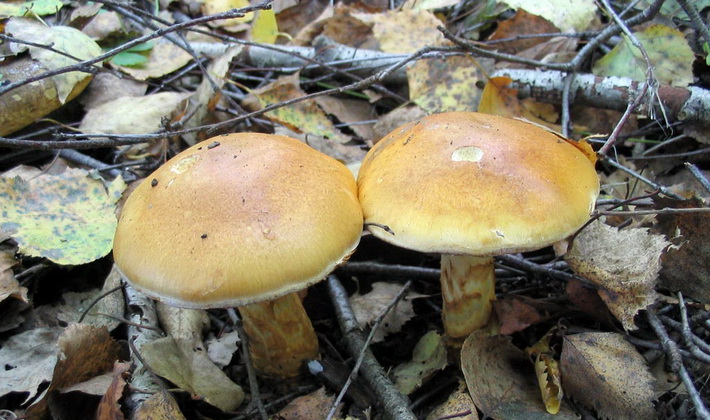
The hat has a diameter of 4-10 cm, sometimes up to 15 cm, first hemispherical, later convex-spread. A distinctive feature of the species is a bright yellow-ocher or honey-yellow hat and a yellowish leg with coarse scales. At the edges of the cap are the remains of the bedspread. The middle of the hat has a darker, brown color, and the edges, on the contrary, are lighter.
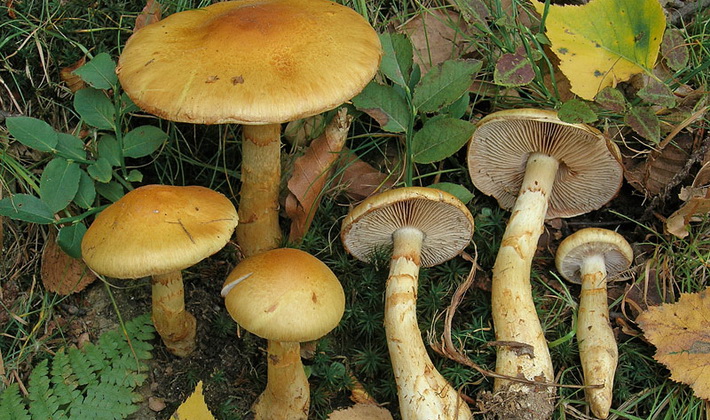
The leg has a height of 5-14 cm and a thickness of 1-2.5 cm, at first it is thick and tuberous with clearly visible membranous dark yellow or brownish belts, later cylindrical with a slight thickening, yellowish, on top with a clearly visible fibrous ring from the bedspread, and in the middle and near the base with several yellow-ocher membranous and coarse scales.
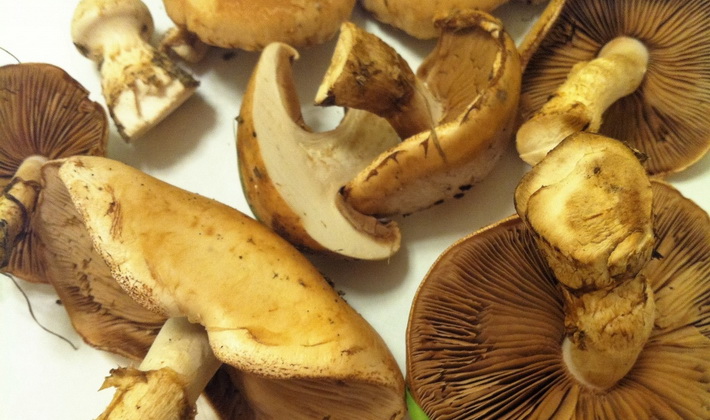
The pulp is light, creamy yellowish, dense, with a pleasant mushroom smell and a bitter taste.
The plates are grown, frequent, wide, first grayish with a bluish tint, later pale ocher and rusty ocher with a bright edge.
Variability. The color of the hat varies from yellow ocher to brownish.
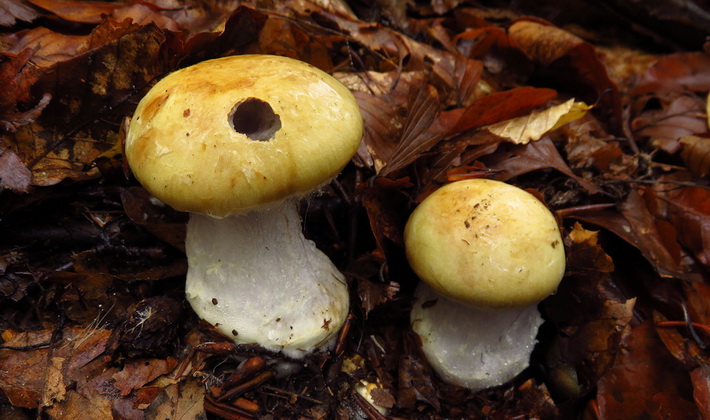
Similar views. The tasty edible cobweb is yellow, or triumphal, in color of the hat is similar to the inedible goose cobweb (Cortinarius anserinus), which has a characteristic smell of plum.
Cooking Methods. The most delicious mushrooms among cobwebs, they are boiled, canned, pre-boiled in 2 waters to eliminate bitterness.
Edible, 3rd category.
Coprinus common (Coprinus cinereus).
Dung beetles differ from other mushrooms in their ability to quickly blacken. Most species of dung beetles are edible, but only at a very young age, when they are strong. After collection, they must be cooked within one to two hours. They are very tasty and tender.
Therapeutic properties:
- A substance has been found in the dung beetle that causes severe discomfort when drinking alcohol. This substance is toxic, does not dissolve in water, but dissolves in alcohol. As a result, when drinking alcohol and dung beetles, poisoning, nausea, vomiting, increased and severe heartbeat, redness of the skin occur. These phenomena usually pass over time. However, if you repeat the intake of alcohol, then all the symptoms are repeated with even greater force. Droppers are used to treat alcoholism. For these purposes, young mushrooms are used.
Habitats: on manicured soil, in gardens, parks, in pastures, in meadows, usually grow in groups.
Season: August - October.
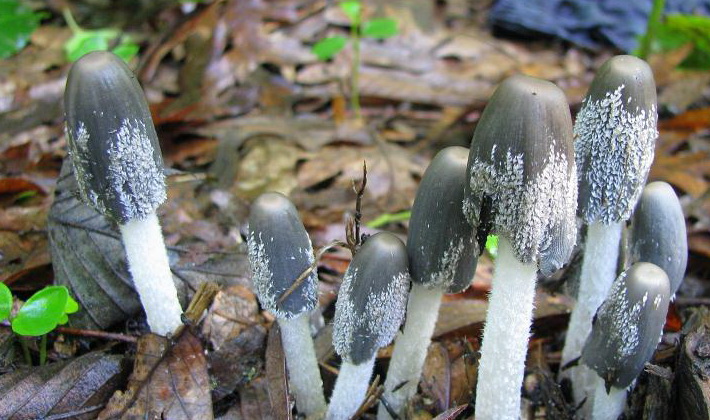
The hat has a diameter of 2-6 cm, first bell-shaped, later prostrate. A distinctive feature of the species is the bell-ovoid shape of a hat of a gray or gray-gray color with a crown of a brownish color, and the surface is covered with white felt coating. The state of the fungus changes dramatically over time: the edges crack and stain in a darker shade, the entire mushroom turns yellow and then darkens, and spreads.
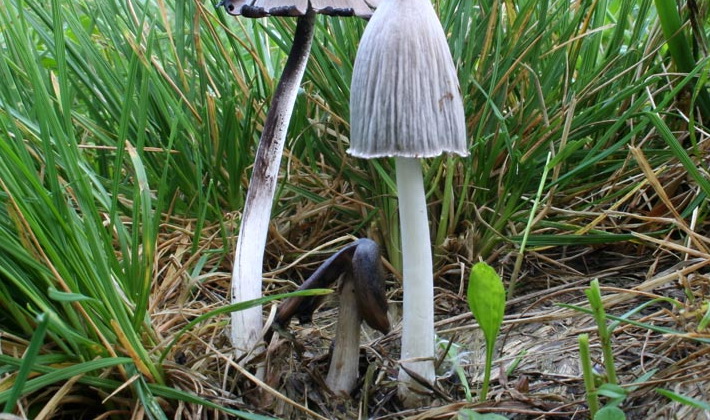
Leg 2-8 cm tall, 2-6 mm thick, long, fibrous, whitish, hollow inside. The base of the leg is slightly thickened.
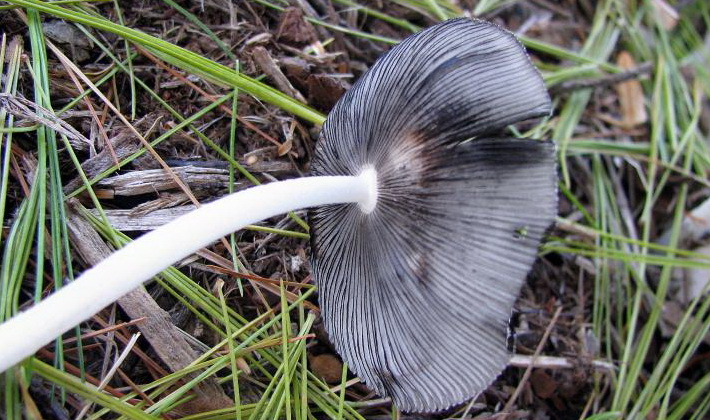
The pulp is first white, later gray, tender, without a characteristic odor and taste.
The discs are frequent, free, first white-gray, then yellow-gray, and finally completely black.
Variability. The color, shape and nature of the cap change dramatically, first gray bell-shaped, later convex-spread, yellowish, and at the end of development - open, yellow-brown, with cracks and darker edges.
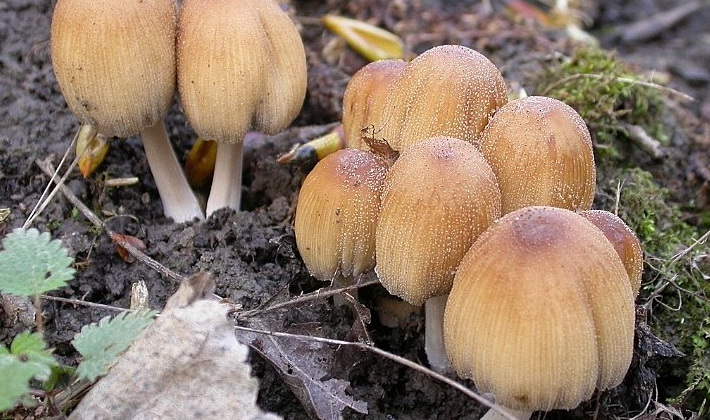
Similar views. The common manure is similar to the shimmering manure (Coprinus micaceus), which is distinguished by the color of the cap - with a pronounced yellowish-brown hue.
Edibility: only young mushrooms are edible, which can be stored for 2-3 hours, after which they are unsuitable for consumption.
Edible, 4th category.
Inedible August Mushrooms
Ordinary gray-brown, or argyraceum (Tricholoma argyraceum)
Most rows growing in August are inedible. Rows of gray-brown grow on small elevations in mixed forests.
Habitats: broad-leaved and coniferous forests with pine and beech, grow in small groups or singly.
Season: July - November.
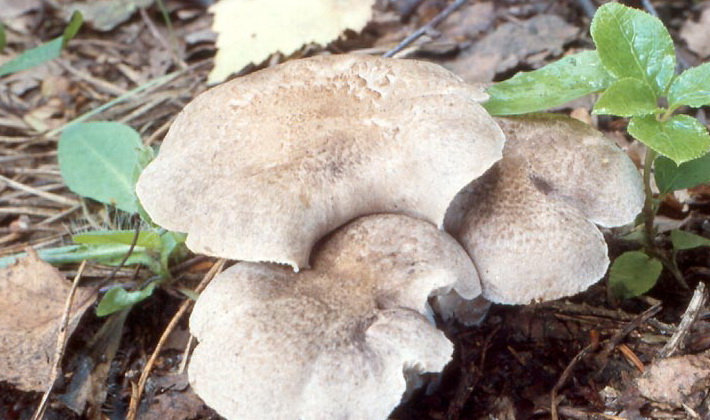
The hat has a diameter of 3 to 8 cm, first strongly convex, later convex and convex-prostrate. A distinctive feature of the species is a scaly, on the edges radial-fibrous hat, similar to a felt surface of gray-brown color with a purple hue.
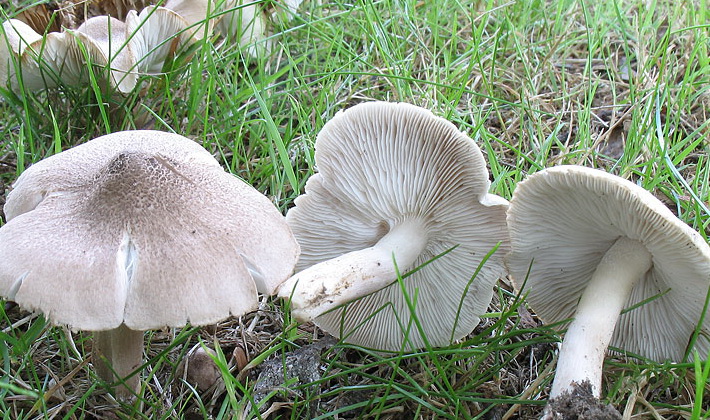
Leg 3-7 cm tall and 6-14 mm thick, cylindrical, often curved, dense, first whitish, later cream, at the base yellowish.
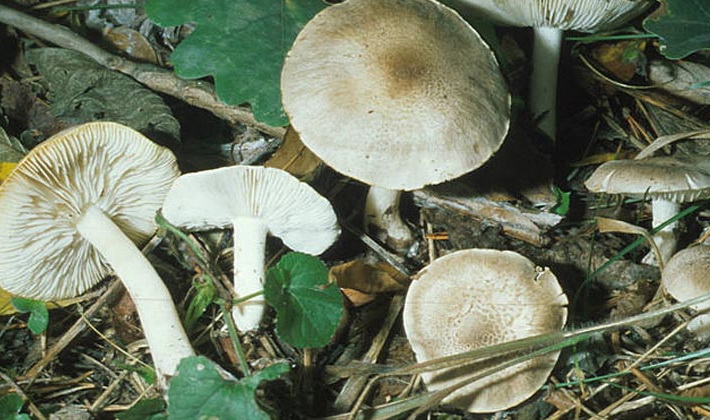
The pulp is tender, fragile, whitish with a faint odor.
Medium-frequency plates, notched or attached to the pedicle, are first cream-colored, later cream-gray, sometimes with a purple tint.
Variability: the color of the hat varies from gray to taupe.
Similarity to other species. The gray-brown row is similar to the earthy row (Tricholoma terreum), which is distinguished by an evenly colored gray hat.
Inedible due to unpleasant taste.
Fly agaric
Amanita is white, or smelly (Amanita virosa).
Habitats: coniferous and deciduous forests grow either in groups or singly.
Season: July - November.
Description of the species.
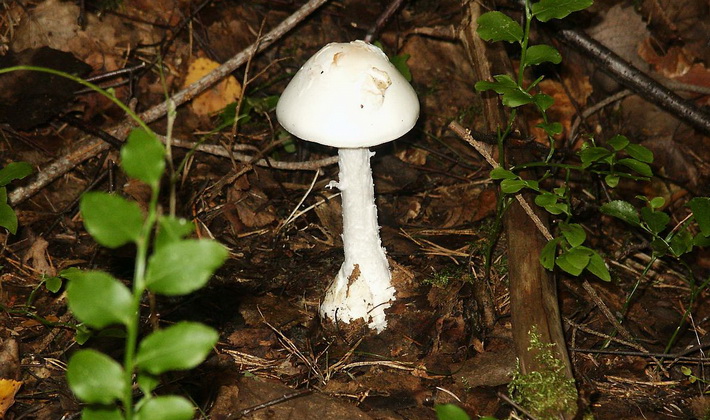
The hat has a diameter of 5-12 cm, first hemispherical or bell-shaped, later convex. A distinctive feature of the species is a smooth shiny white or ivory hat and the same plate color regardless of age, as well as the presence of a wide white Volvo, immersed at the base in the soil. The hat is usually covered with the remains of the bedspread.

The leg is long, 6-20 cm high, 8-20 mm thick, white, with a powdery coating. Only young specimens have a leg ring, then it disappears. White Volvo in the ground has dimensions up to 3 cm, but with the fungus is not pulled out.
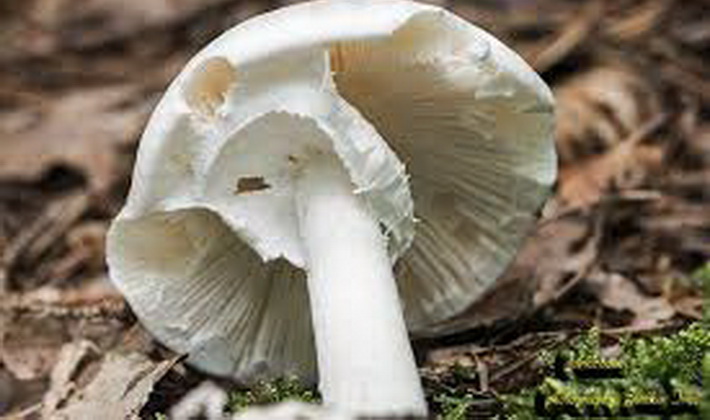
Pulp: white, soft with an unpleasant odor, for which they called the species smelly.
The discs are free, frequent, soft, white.
Variability. The color of the hat does not change much - from pure white to ivory.
Similar views. One must be especially careful when collecting good edible champignons - meadow (Agaricus campestris), large-spore (Agaricus macrosporus), field (Agaricus arvensis). All these champignons at an early age have light plates with a slight yellowish or subtle pinkish tint and light hats. At this age, they can be confused with the deadly poisonous fly agaric white, or smelly. Mushrooms should be carefully sniffed, since the fly agaric has an unpleasant smell, this is the main difference for a young age. In adulthood, the plates of all these champignons are light brown, pink, brownish, while in the fly agaric they remain white.
Deadly poisonous!
Fly agaric (Amanita citrina).
Habitats: coniferous and deciduous forests, on acidic soils, grow either in groups or singly.
Season: July - October.
Description of the species.
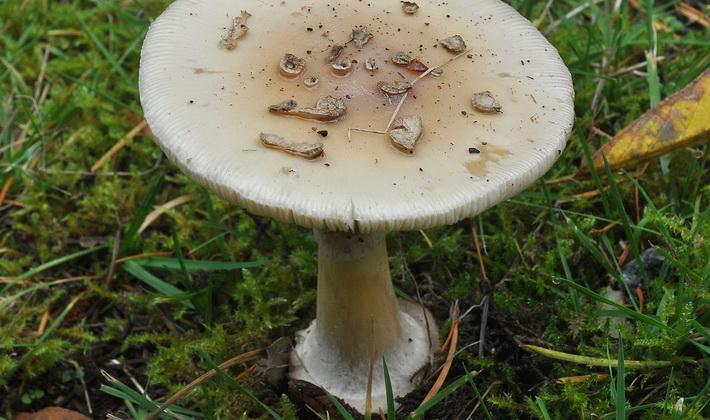
The hat has a diameter of 4-10 cm, first spherical, later convex. A distinctive feature of the species is a yellowish-greenish hat with large bright spots from the scales, as well as a smooth leg with a large ring and a thickening at the base, surrounded by a Volvo. At the edges there are remains of the bedspread.
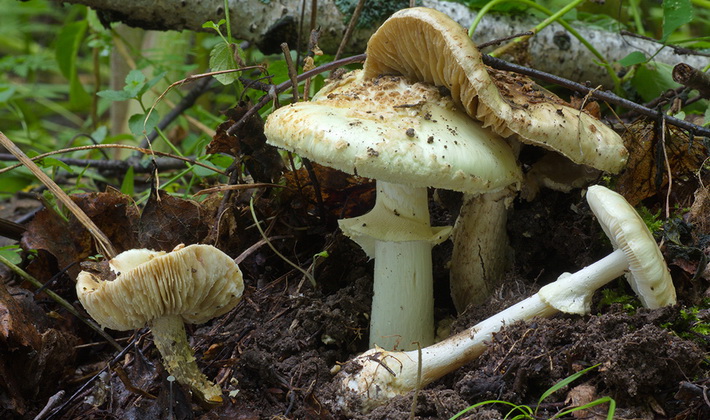
Leg is long, 4-10 cm high, 7-20 mm thick, white or yellowish, with powdery coating. On the leg of the upper part there is a large, drooping ring of the same color as the hat, or whitish. Below the leg is tuberoid-expanded and is located in a whitish Volvo.
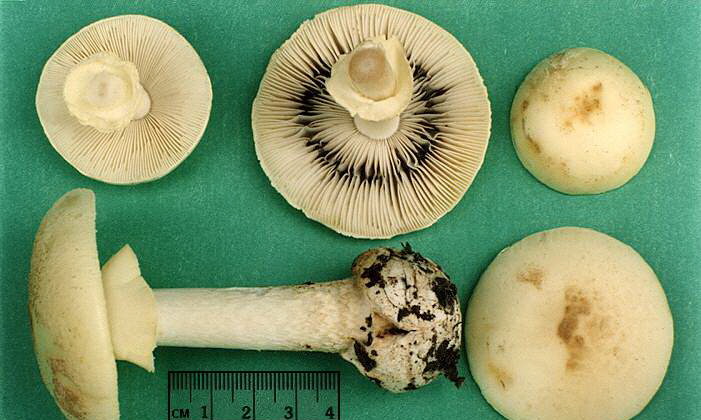
Pulp: white, with the smell of raw potatoes.
The discs are free, frequent, soft, white or yellowish.
Variability. The color of the hat does not change much - from yellowish-green to greenish-bluish to ivory.
Similar views. One must be especially careful when collecting good edible champignons - meadow (Agaricus campestris), large-spore (Agaricus macrosporus), field (Agaricus arvensis).All these champignons at an early age have light plates with a slight yellowish or slightly noticeable pinkish tint and light hats.
At this age they can be confused with deadly poisonous fly agaric mushrooms. Mushrooms should be carefully sniffed, as the fly agaric smells of raw potatoes, this is the main difference for a young age. In adulthood, the plates of all these champignons are light brown, pink, brownish, while in the fly agaric they remain white.
Poisonous.
Mycena adonis, or purple (Mycena adonis).
The mycene cluster is a harbinger of the mushroom season. If there are a lot of them, if stumps are stuck with them, then this is a clear sign that there will be many good valuable mushrooms. These small inedible and hallucinogenic mushrooms are very diverse. A common symptom is a thin leg and a thin hat.
Habitats: in humid places, among moss, they grow in groups.
Season: July - October.
Description of the species.
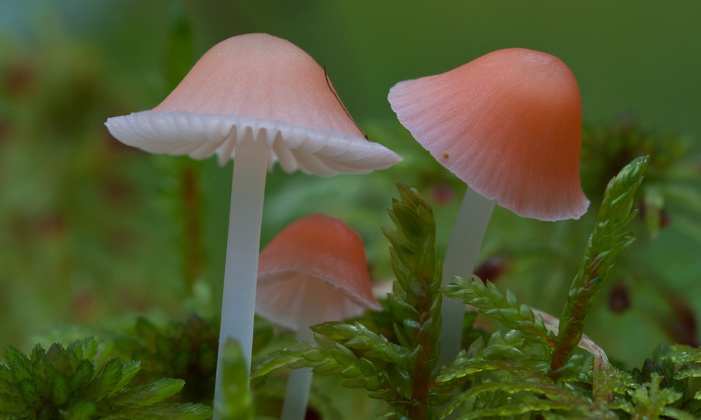
The hat has a diameter of 1-1.5 cm, first bell-shaped, then convex. A distinctive feature of the species is a very tuberous hat in the center, red-brown, coral-pink, tan or purple, with a furrowed and shaded lighter pinkish-cream edge.
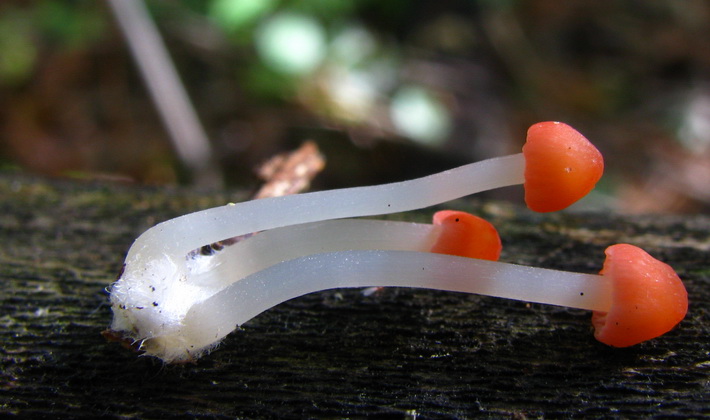
The leg is thin 4-7 cm tall, 1-2 mm thick, cylindrical, smooth, has a creamy white color on top, brownish below.
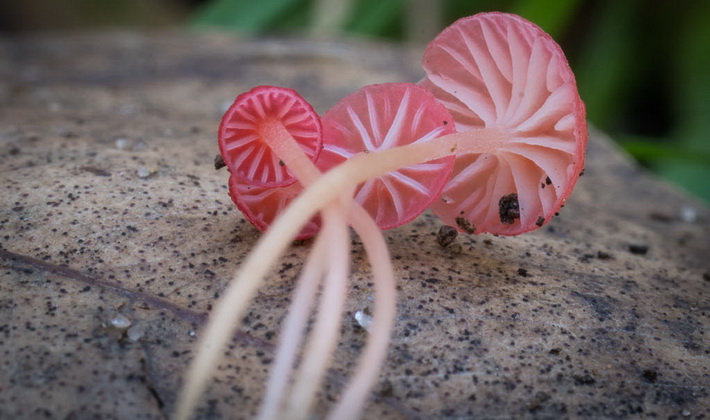
The pulp is thin, light cream.
Medium-frequency discs, narrow, first grown, later notched-grown, wide, whitish with a flesh-tinged, sometimes creamy pinkish.
Variability: the color of the hat in the middle varies from pinkish-brown to purple, and on the edges from cream to pinkish. The furrowed edge is lighter and eventually bends.
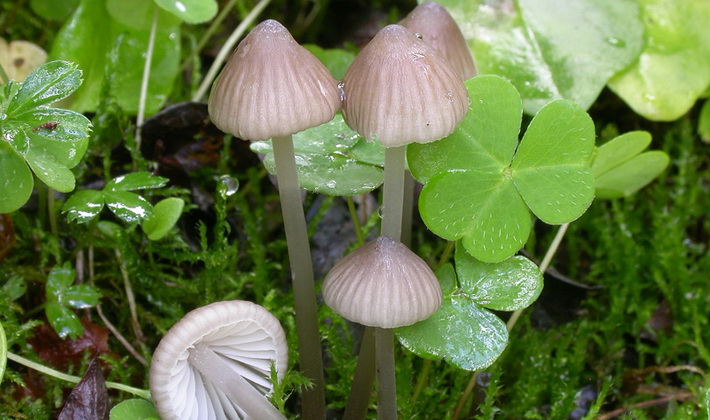
Similar views. Mycena adonis is similar in shape to Mycena Abramsii, which is distinguished by a lighter, yellowish-pink and larger hat.
Edibility: an unpleasant odor is difficult to soften with a decoction in 2-3 waters, for this reason they are not consumed.
Inedible.
Spiky Scale (Pholiota shaggy).
These August mushrooms are very widely represented in mixed forests. Most of them are inedible and grow on stumps and fallen trees, less often on roots.
Habitats: on decaying trunks of deciduous trees, usually grow in groups.
Season: August - October.
Description of the species.
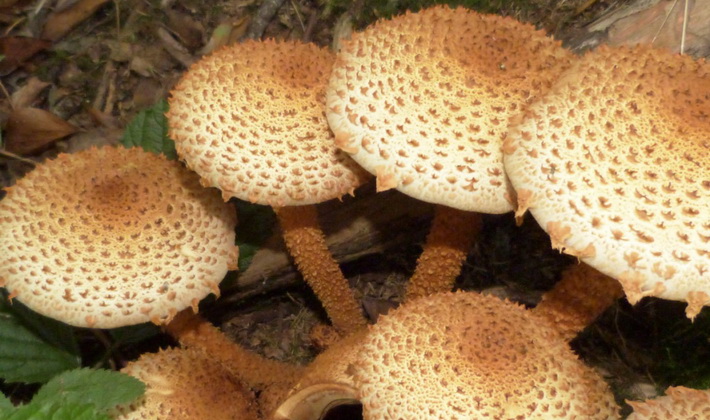
The hat has a diameter of 3-12 cm, first convex, later convex-spread. A distinctive feature of the species is a light beige or light straw hat with sharp spikes of light brown color. The edges of the hat crack over time.
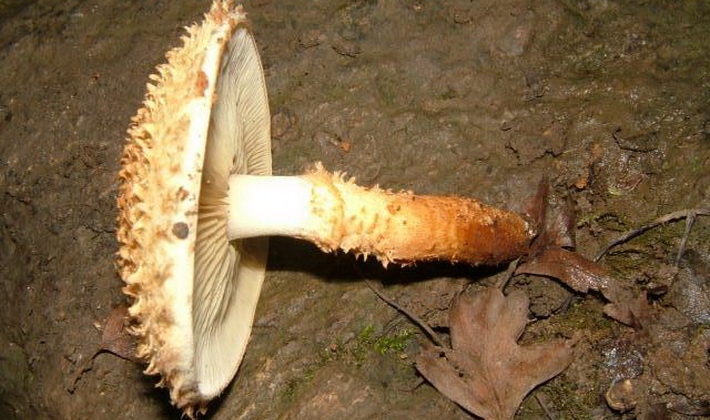
The leg has a height of 3-10 cm, a thickness of 5-12 mm. The leg is first white, later cream, and at the base - brownish with scales.
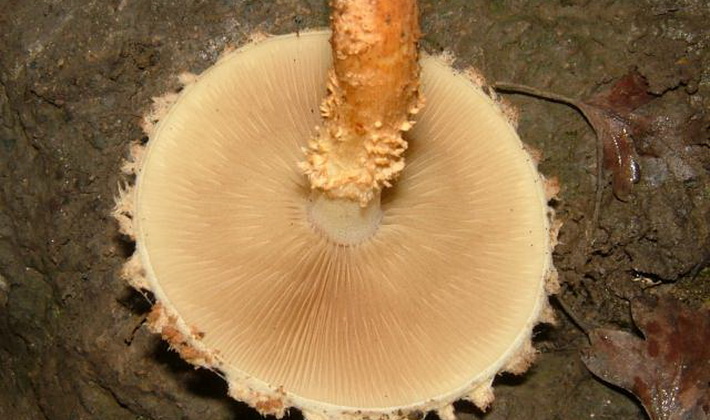
Pulp: first white, later light cream.
The plates are frequent, first grown and whitish, later notched-attached and creamy with a pinkish tinge.
Variability. The color of the hat changes from light beige to light brown with growth.
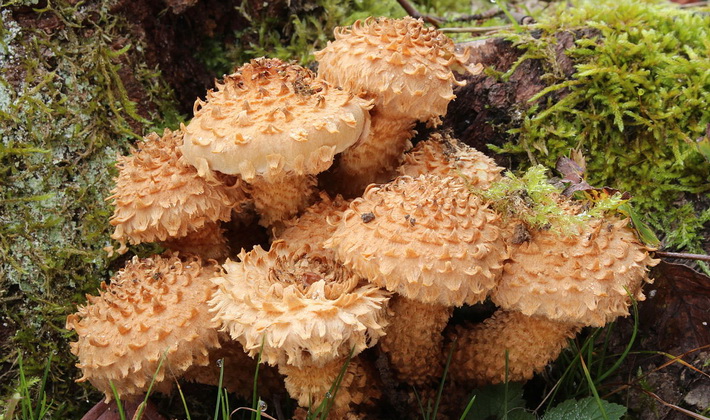
Similar views. The spiky flake is similar to the flake, or ordinary flake (Pholiota squarrosa), which is characterized by a reddish-brown color of the hat.
Inedible.
